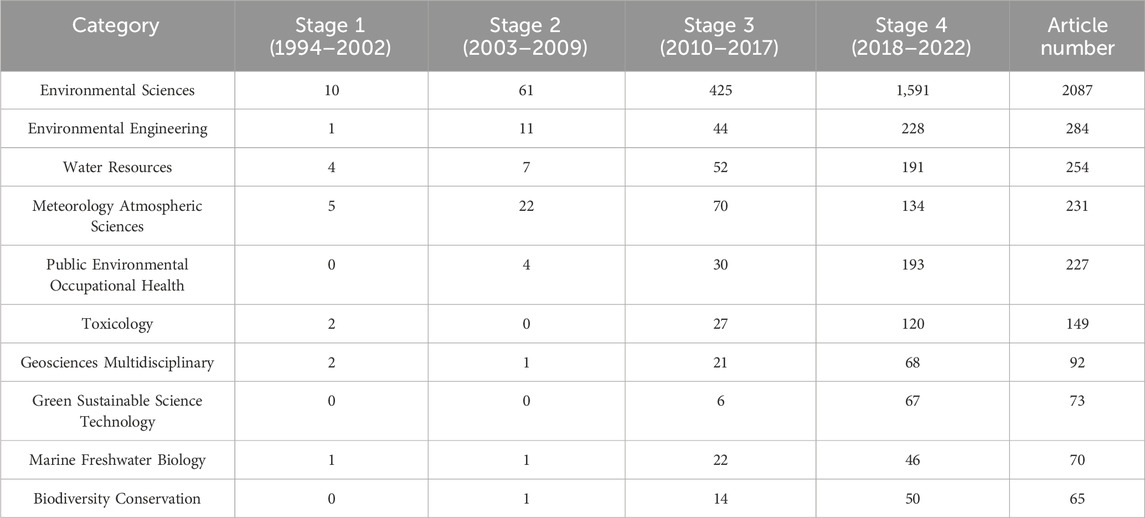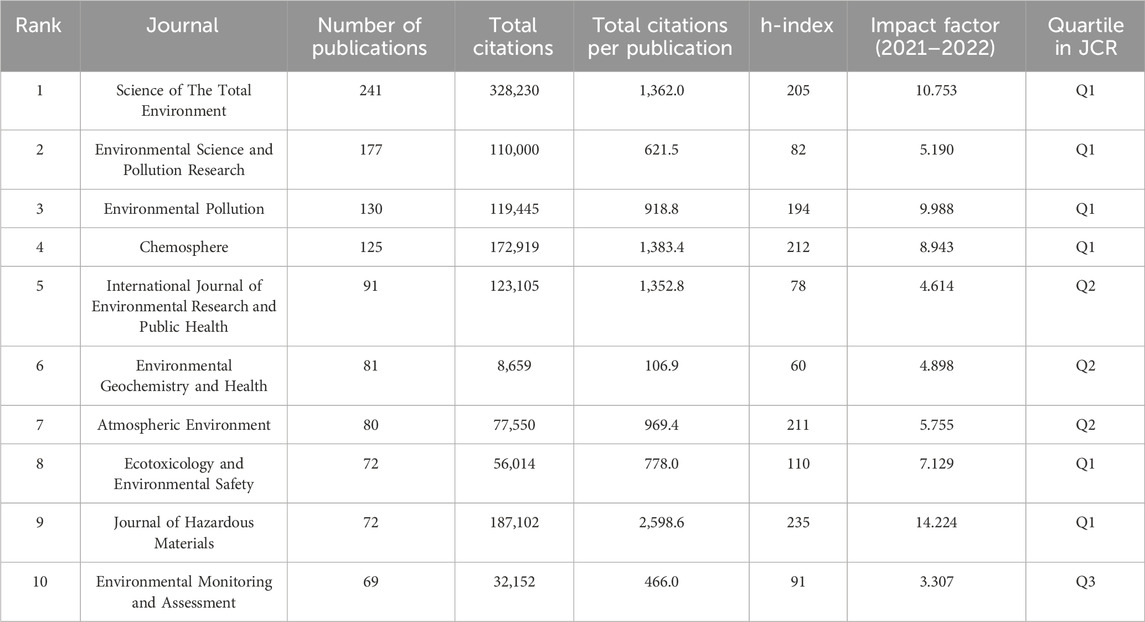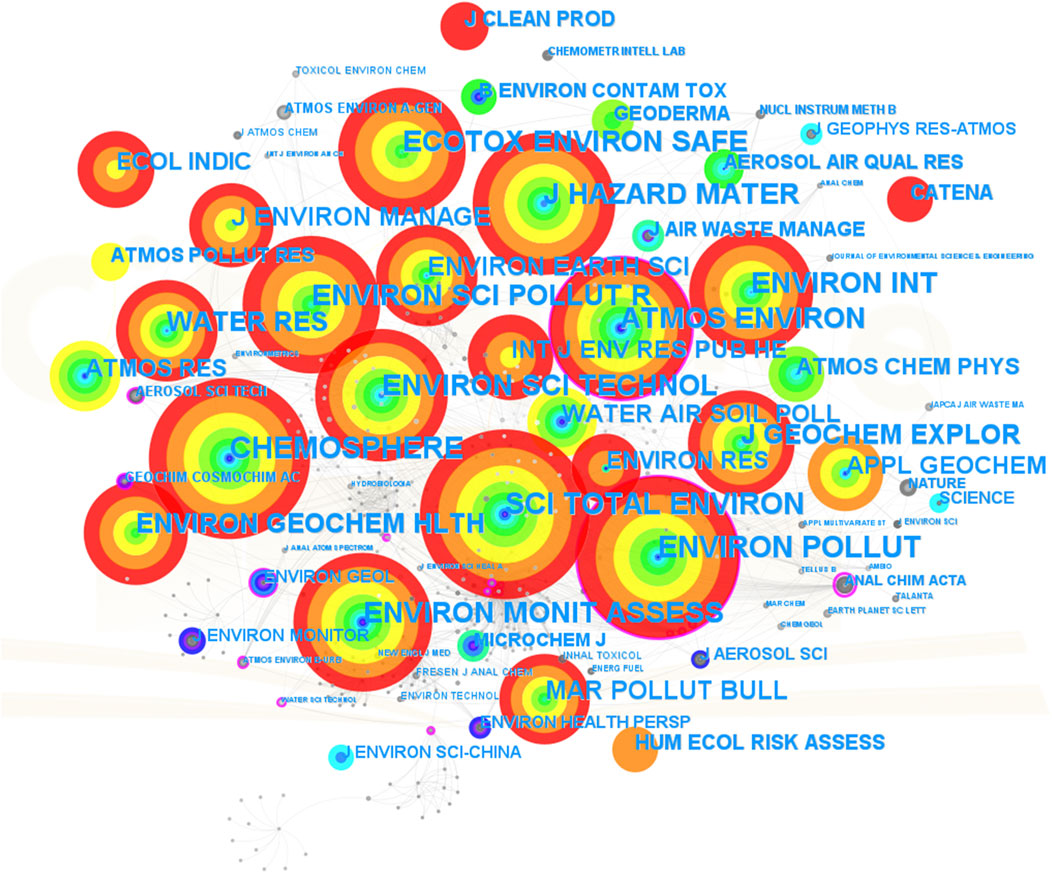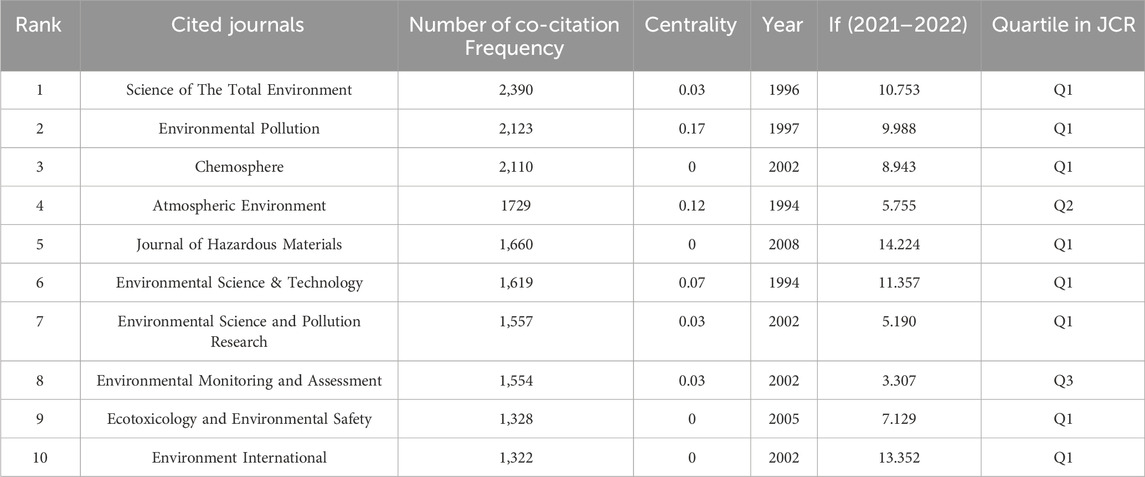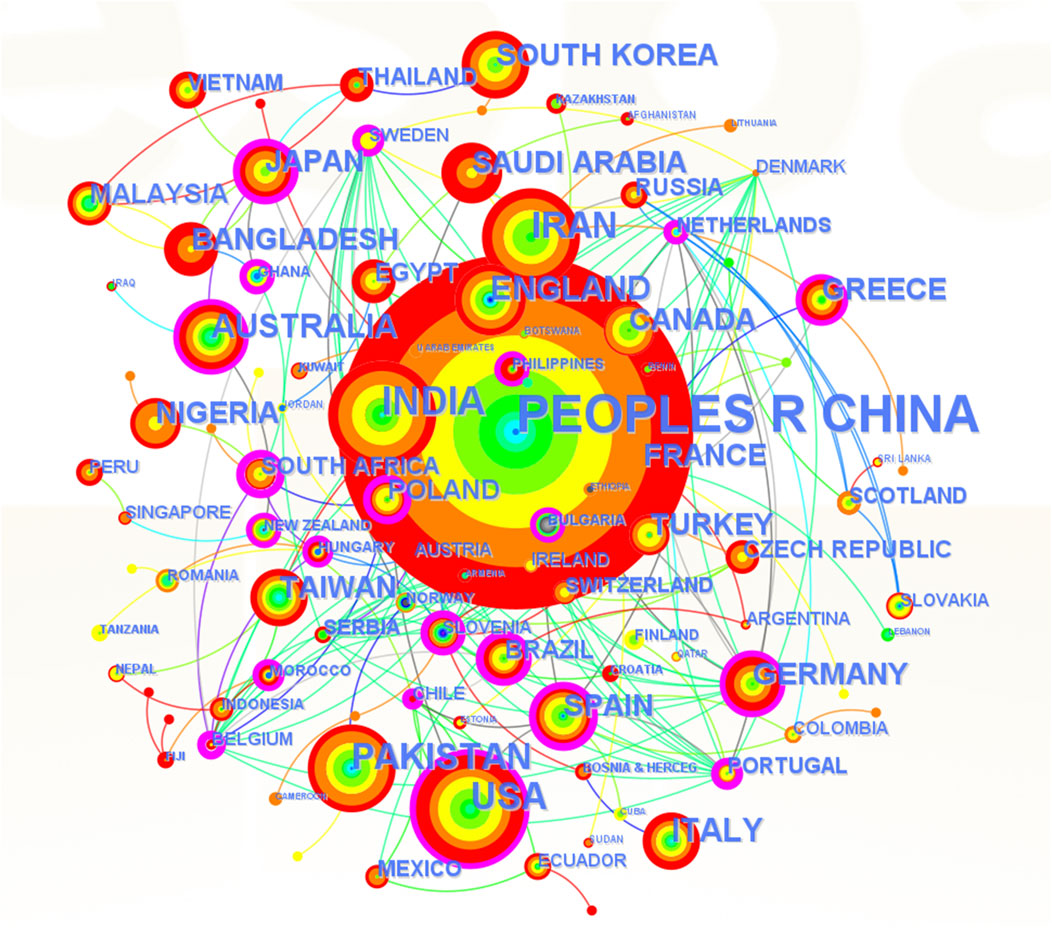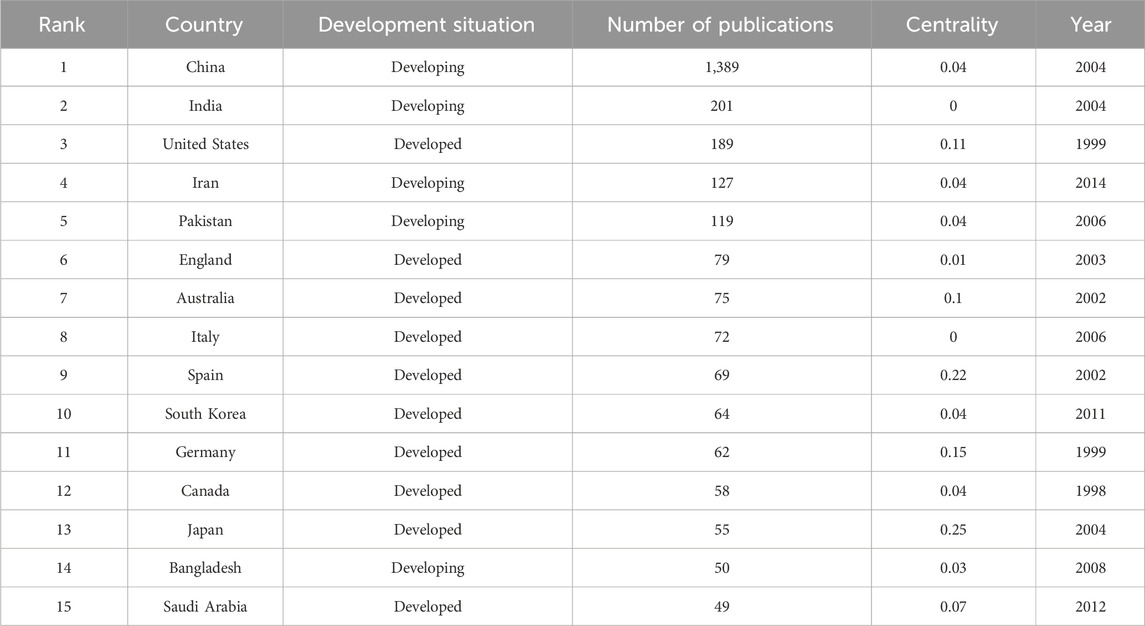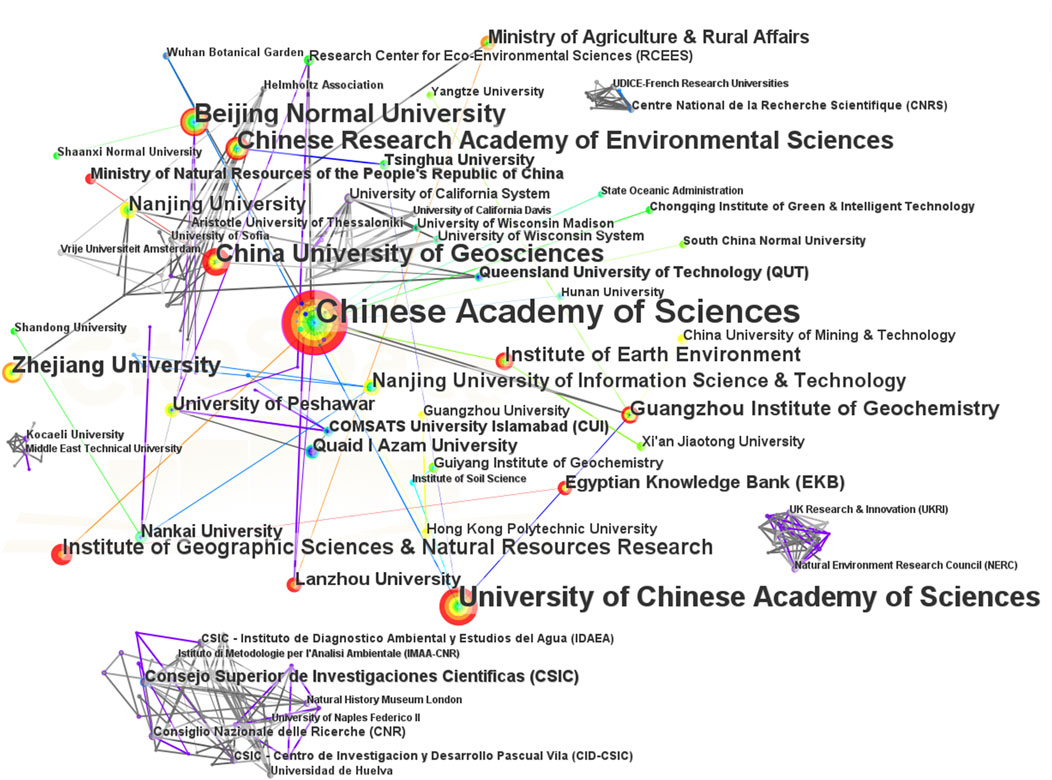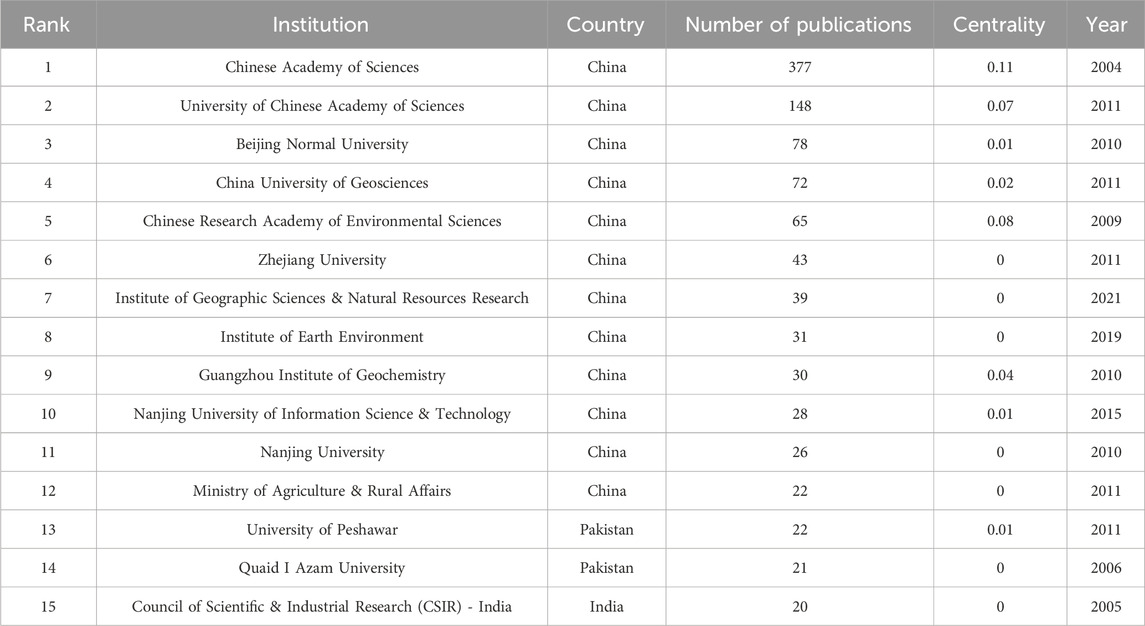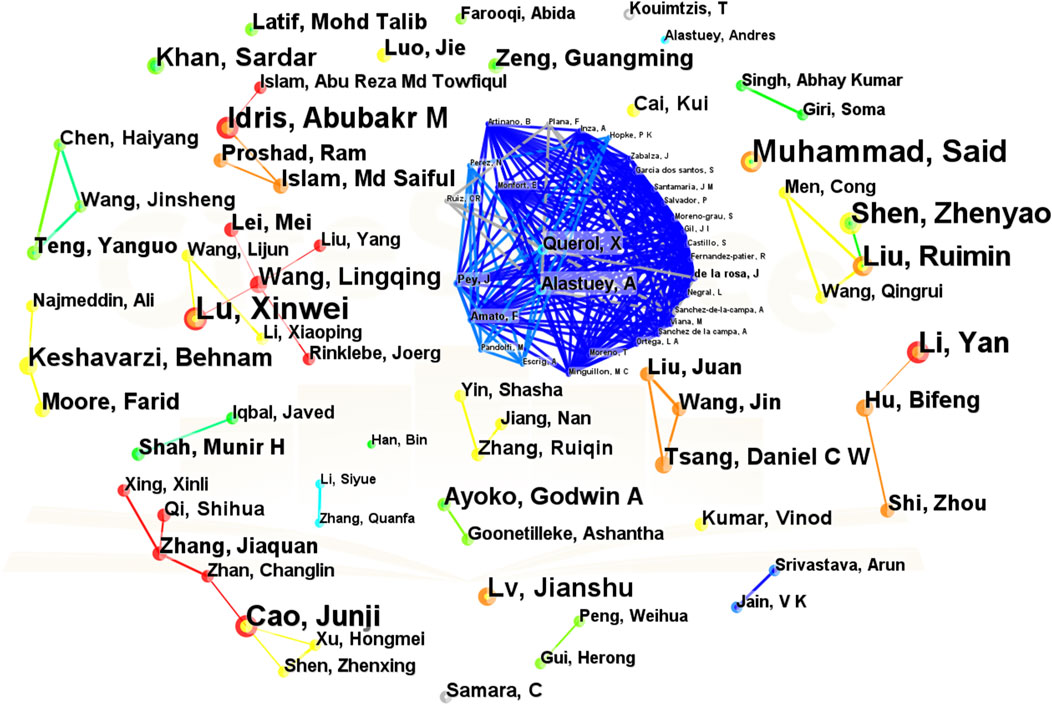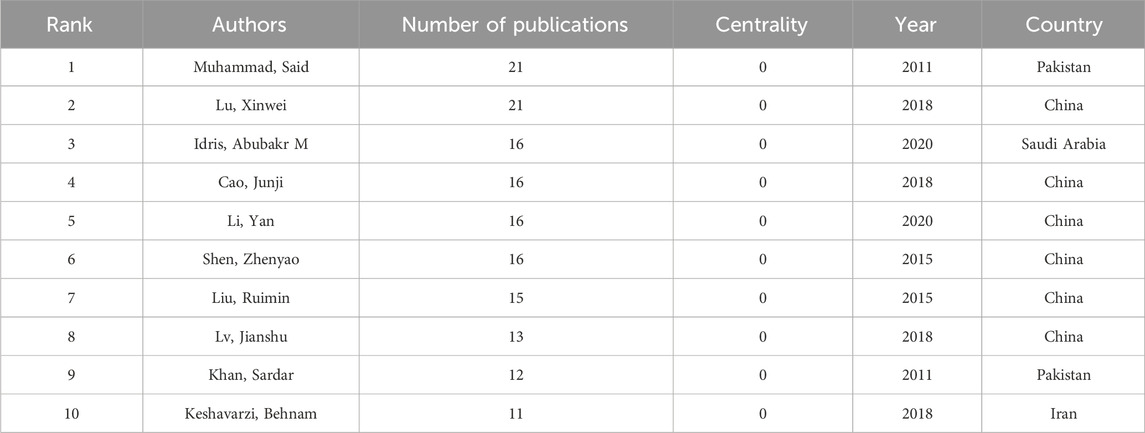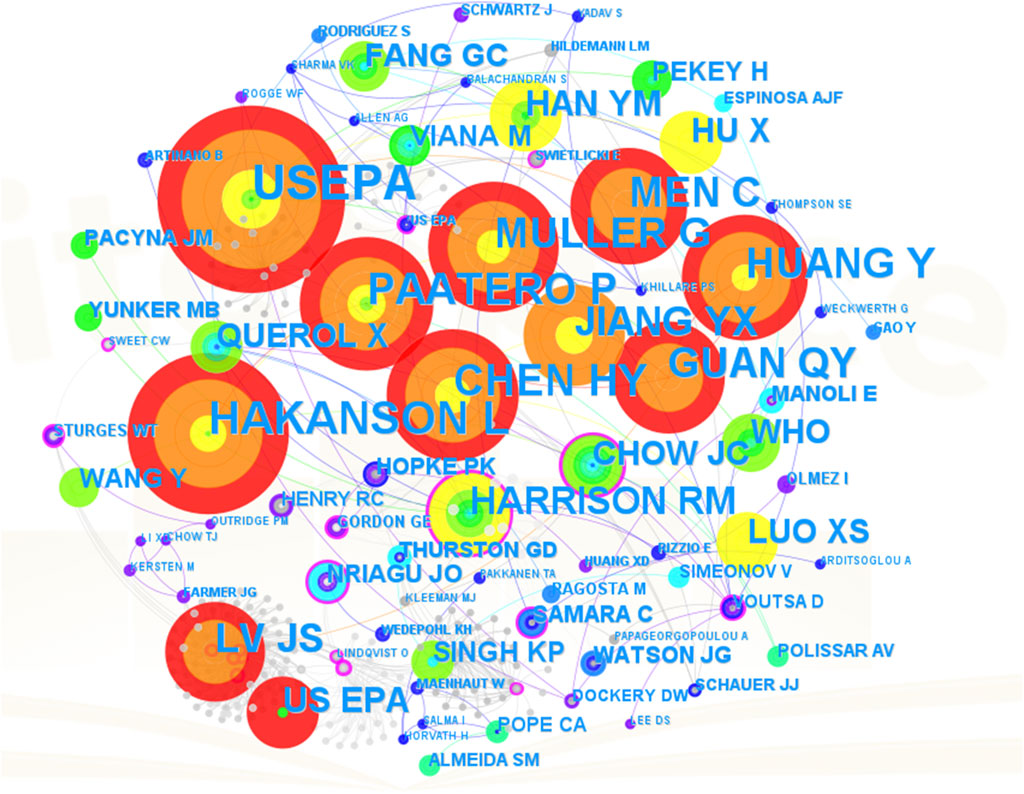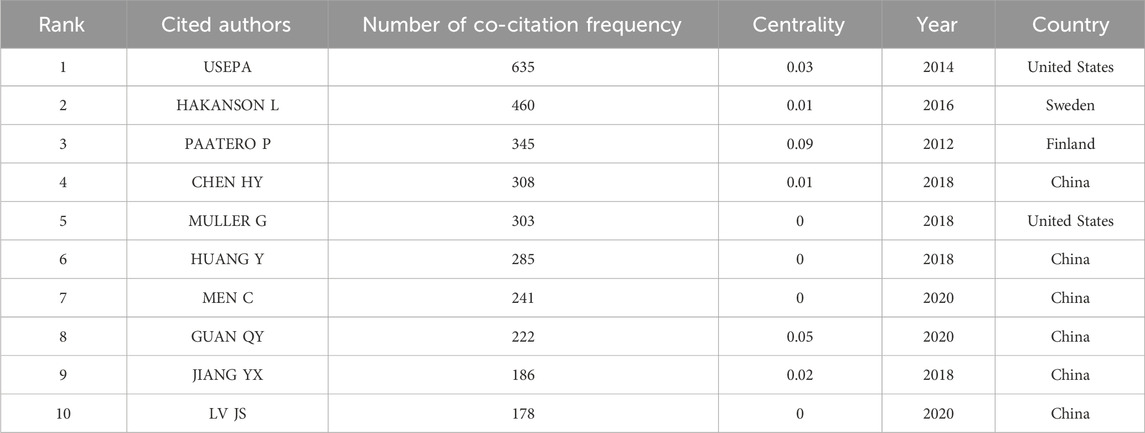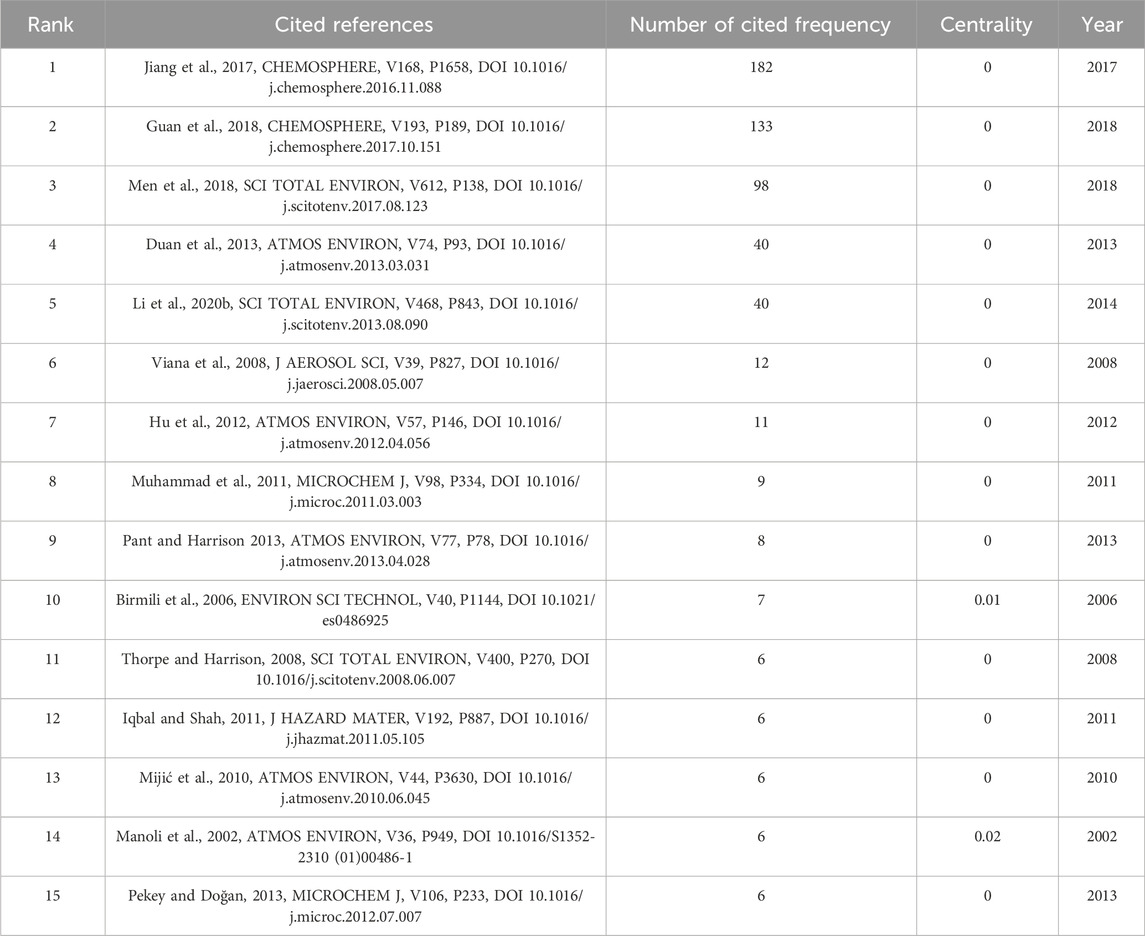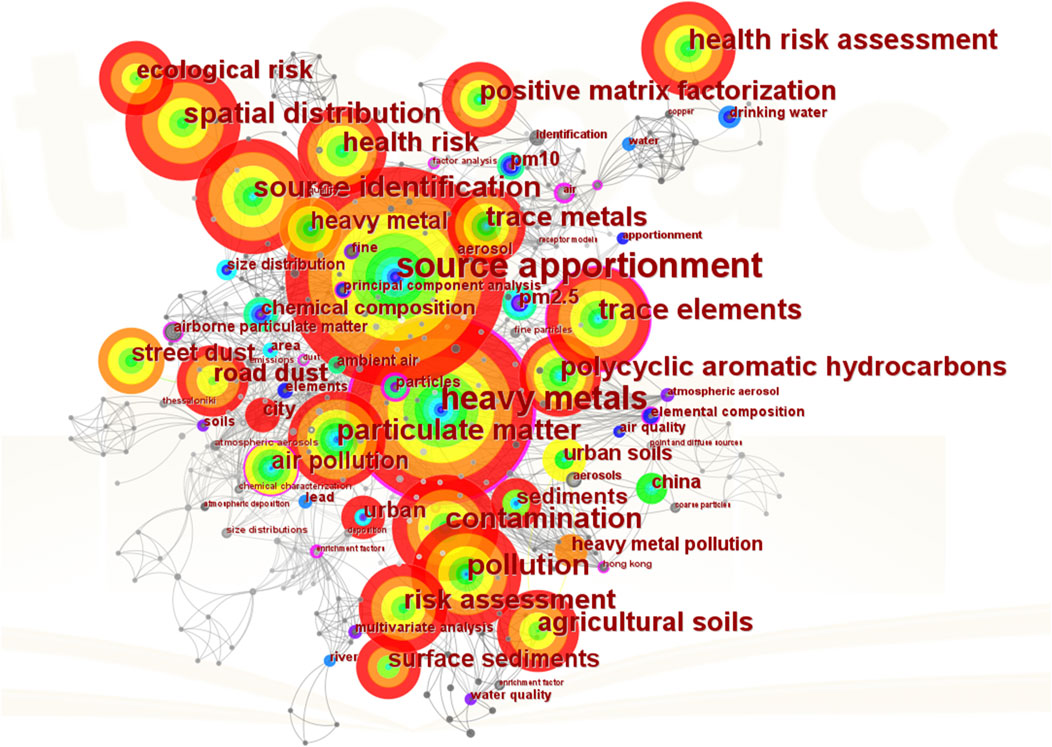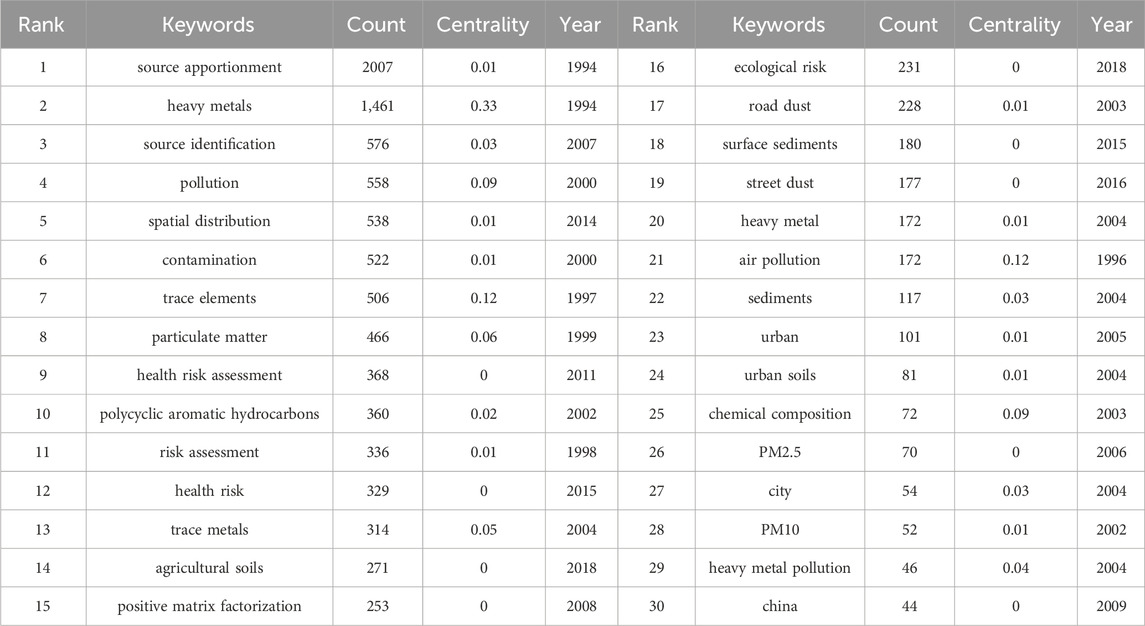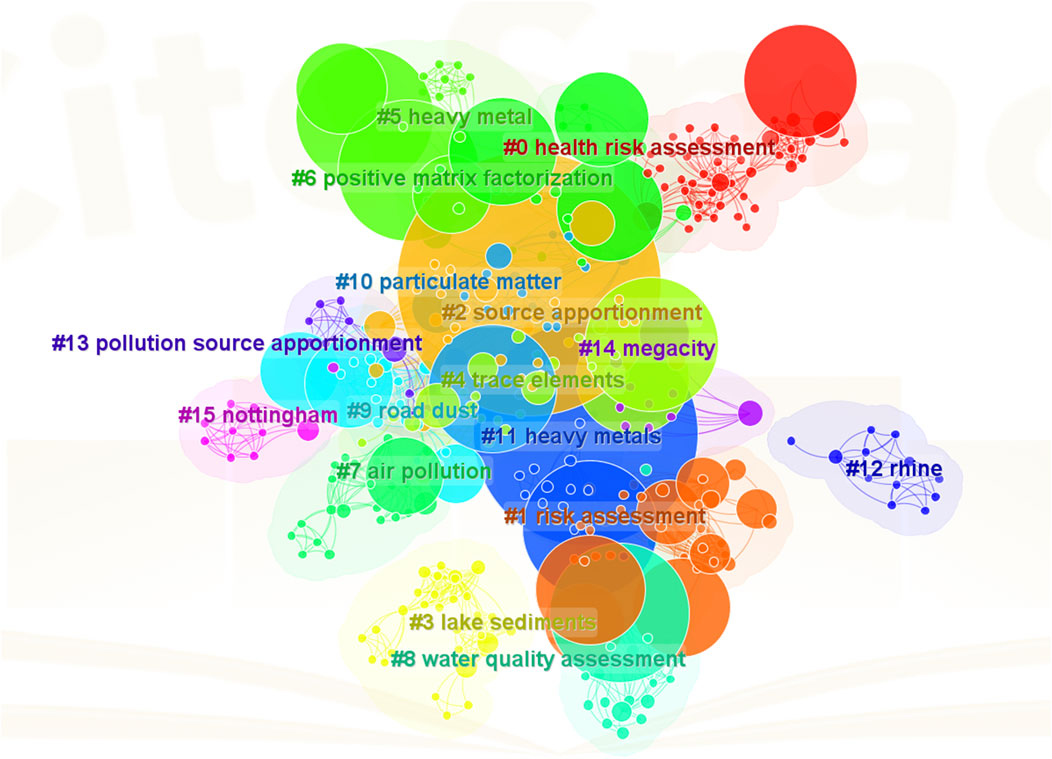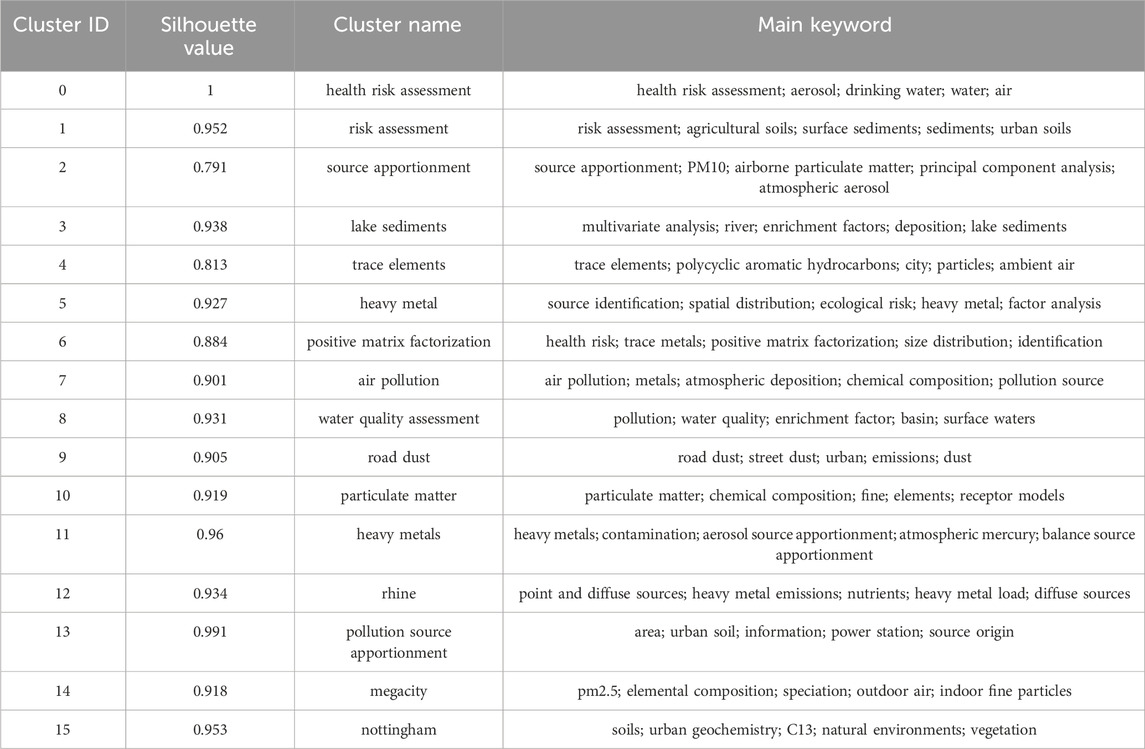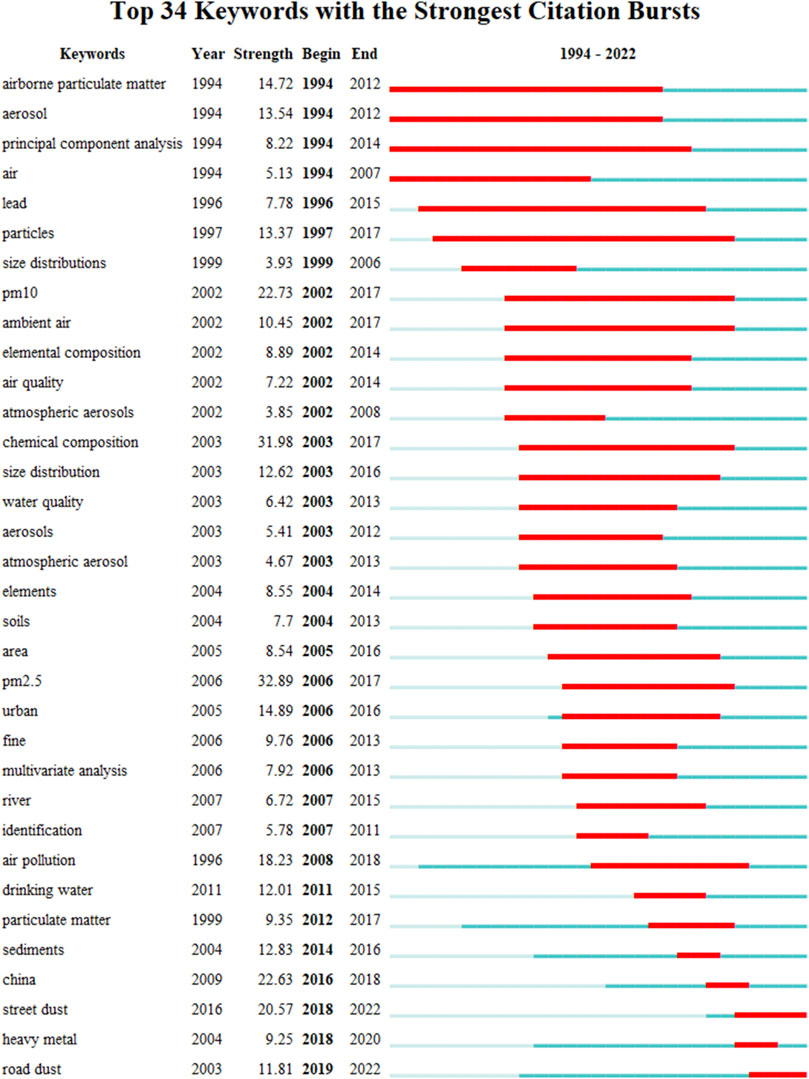- 1Institute of Farmland Irrigation of CAAS, Xinxiang, China
- 2College of Energy and Environment Engineering, Hebei University of Engineering, Handan, China
- 3Institute of Environmental Planning and Management, College of Environmental Science and Engineering, Tongji University, Shanghai, China
In recent decades, more and more studies have been conducted on source appointment of heavy metals, since they can accumulate in the food chain and have a negative impact on the ecological environment and human health. However, almost never before had scholars tried to make a comprehensive and methodical review in this field from the scientometric and bibliometric perspective. The purpose of this review is to offer insights into the research topics and trend evaluation in terms of source appointment of heavy metals over time using the visualization and analysis software, CiteSpace. We retrieved a total of 2,533 articles from the Web of Science Core Collection (WoSCC) dated between 1994 and 2022, and analysed the progress, hotspots, and trends in this field by synthesized networks of cooperation analysis, co-citation analysis, keyword co-occurrence and cluster analysis, and keywords burst analysis. The overall development of the topic can be divided into four periods, and the rapid development began from 2010. Environmental Sciences was the leading subject category, and the journal Science of the Total Environment had the highest number of publications (9.51%), which was most cited as well (2,390 times). China published the most articles in this field, in which Chinese Academy of Sciences was the leading institution. Said Muhammad and Xinwei Lu were the top two most productive authors. According to citation frequency, Hakanson L was the movers and shakers. Keyword co-occurrence and cluster analysis results showed that “the health risk assessment,” “lake sediments”, “trace elements,” “positive matrix factorization,” “air pollution,” “road dust,” and “megacity” are likely to be hotspots. The “particulate matter,” “China,” “sediments” and “road dust” demonstrated the research tendencies of this domain by keyword burst analysis.
1 Introduction
With the rapid development of industrialization and urbanization in the world, heavy metals pollution in the environment has become common on a global scale, and it interferes with the natural geochemical cycle of the ecosystem. The sources of heavy metals in the environment can be divided into natural sources and man-made sources. The natural source is influenced by geological background and weathering of parent rock. Man-made sources are affected by human activities, including mining, smelting, transportation, the improper discharge and use of industrial wastewater and domestic sewage, and the overuse of pesticides and fertilizers (De Temmerman et al., 2003; Chary et al., 2008; Cai et al., 2009; Lu et al., 2012). Heavy metals are relatively stable once entering the environment and difficult to be degraded, hence heavy metal pollution has concealment, lag and stability (Jacob et al., 2018). In addition, heavy metals can also enter the human body through a variety of ways, thereby endangering human health (Zhang et al., 2018; Duan et al., 2020; Wang X. et al., 2023; Zhou et al., 2023). The source apportionment of heavy metals can effectively identify the main sources of heavy metals, which makes it possible to control the environmental pollution from the source and to make better prevention and control measures (Dong et al., 2019; Banerjee et al., 2023; Sun et al., 2023; Zhang et al., 2023; Zou et al., 2023). Therefore, source apportionment is very important for effectively alleviating pollution of heavy metals.
In recent years, the field of source apportionment of heavy metals has attracted more and more scholars’ attention, and many articles on source apportionment of heavy metals have been published, including review articles (Cheema et al., 2020; Sun et al., 2020; Chu et al., 2023). With the involvement of scholars in various fields, the source analysis techniques have become more diversified. Existing source apportionment can be classified into source identification and source quantification. Source identification defines the types of pollution sources, while source quantification determines their contribution (Xue et al., 2023). So far, there are a tremendous number of methods for the source apportionment of heavy metals. Multivariate statistical analysis is the traditional source apportionment method (Simeonov et al., 2005), which includes Diffusion Model and Receptor Model (Henry et al., 1984). The diffusion model is based on the emission intensity of pollution sources, combined with the geographical location, climate and other factors, to simulate the process of pollutant transmission and transformation, and then quantify the contribution of pollution sources. Diffusion Model includes geostatistics and mixed distribution model method, etc. (Xu and Tao, 2004; Lee et al., 2006). The receptor model takes the polluted area as the research object, carries out the qualitative and quantitative analysis for the pollutants in the samples of the studied area, and combines the model algorithm to identify the kind of pollution sources, which is the most widely used model in the field of the source apportionment of heavy metals. The enrichment factors (EFs), factor analysis (FA), cluster analysis (CA), principal component analysis (PCA), absolute principal component analysis (APCS), chemical mass balance (CMB), positive matrix factorization (PMF), empirical orthogonal functions (EOF), multiple linear regression (MLR), UNMIX, and other multivariate data analysis methods are the commonly used receptor models (Watson et al., 2002; Xue et al., 2014; Wang et al., 2015; Huang et al., 2018; Xu et al., 2023a; Khan et al., 2023). In addition to the above, the isotope tracer technique has also been widely used recently (Chen et al., 2022; Shen et al., 2023). The Diffusion Model and Receptor Model both possess advantages, uncertainty and other inevitable disadvantages. Therefore, most researchers often combine multiple models to carry out source apportionment of heavy metals, making the results more accurate and reliable (Liu et al., 2018; Men et al., 2019; Wang Y. et al., 2021). These published literatures focus on how to use source apportionment methods, which indicates that the research progress of source apportionment of heavy metals has been neglected to a certain extent. We think it is necessary to summarize the development of this field and predict the future trend. By conducting a systematic scientometrics review of the field, it is possible to explore the scope of research, quantify research models, clarify knowledge structures, predict emerging trends, and fill gaps in the existing published literature. In addition, mapping and visualizing the structure and dynamics of a research field helps to quickly organize a large number of published articles and efficiently grasp the progress and frontiers of the research field.
Bibliometrics analysis is a discipline that performs qualitative and quantitative analysis of all publications included in a database, based on statistics and computational techniques (Aleixandre-Benavent et al., 2017; Liu et al., 2019). Through bibliometrics, the development process, characteristics and future trends of a certain field can be clearly and succinctly summarized (Batagelj and Cerinšek, 2013; Martínez et al., 2015; Gutiérrez-Salcedo et al., 2018). To date, bibliometrics has been widely used in different studies by scholars in various fields (Ekundayo and Okoh, 2018; Wang et al., 2018). Based on co-occurrence, clustering and emergent analysis of literature information and other bibliometrics methods, the science knowledge map in a certain research field can be visualized in the form of graphs and tables (Fu et al., 2022; Liu M. et al., 2023), by which researchers can get a more intuitive understanding of this research field (Osinska and Bala, 2015).
It is difficult to obtain valuable information directly from a large number of literatures, which requires the assistance of computers. Since the introduction of visualization in bibliometrics, there are many scientific knowledge mapping tools available today. Citation Space (CiteSpace), VOSviewer, CitNetExplorer, SCI2, and Gephi are the commonly used scientometrics softwares (Light et al., 2014; Van Eck and Waltman, 2014; 2017; Donthu et al., 2020; Ding and Yang, 2022). Among them, CiteSpace has some advantages. CiteSpace is a visual analysis software developed by Dr. Chaowei Chen on the basis of bibliometrics and data visualization, and the analysis is based on the premise of cited literature information (Chen, 2004), and carried out from multiple dimensions when figuring out the development of a certain field. And it is capable of conducting time domain analysis and burst detection to more accurately show the dynamic change of information in the research field (Meerow et al., 2016; Yang et al., 2017; Chen and Song, 2019). Compared to other software, it can be run without a complex java environment, and updated easily. In addition, its results are presented visually. When the citation data is large or involves a long period of time, CiteSpace provides some network pruning algorithms, such as MST or Pathfinder, to highlight the main body by reducing unnecessary weak branches.
CiteSpace has been successfully used in many cases. For example, using CiteSpace software, a bibliometrics analysis was conducted on the development of PAHs bioremediation in water environment from 1990 to 2022, and the basic characteristics, hotspots and prospects of the research field from the perspective of time and space were discussed (Xia et al., 2023). Nearly 25 years of data in China’s climate resilient infrastructure were analyzed by Yijun Liu et al. using CiteSpace to provide guidance for urban planning and construction (Liu Y. et al., 2023). Based on CiteSpace, a comprehensive understanding of sediment and nutrient interception in river DAMS was obtained (Shi and Qin, 2023). This software is also gradually applied in the source apportionment of heavy metals (Wang J. et al., 2021), the relevant literature is however very scarce, and up to now, no scholars have conducted a complete, intuitive and reliable analysis in the research progress of source apportionment of heavy metals in various environmental media. Review articles in this field generally focused on introducing the source appointment methods, or used summary language to quickly bring readers up to speed on the latest developments in the field. While this kind of landscape fails to present the whole picture of the research field and its dynamics, and the identified emerging trends by which has certain limitations (Wu et al., 2021). Specifically, at present, there is a lack of systematic review of the research field of source apportionment of heavy metals, hindering the sufficient understanding of the characteristics and emerging trends of existing research as well as the development of research. Consequently, it is very necessary to summarize the development process of this research field, point out the shortcomings of the present study, and predict the future development trend.
This review aims to comprehensively get the whole picture of the research field of source apportionment of heavy metals by answering the following questions: 1) What is the change trend of the number of papers published in this field? What is the overall development process of this field? What are the characteristics of the development of this field? Is this field gaining more scholars attention now? 2) In the development process of this field, what are the important subject categories, journals, countries, institutions, scholars, and literatures? How is the cooperation between countries, institutions and scholars? 3) Do the research hotspots in this field change significantly with years? How has it changed? 4) How will this field develop in the future? The visual analysis work using CiteSpace (6.2.R2) in this review was carried out to summarize the overall development process in this field from 1994 to 2022.
2 Data acquisition and methods
2.1 Data collection
Web of Science (WoS) is the worldwide premier scientific index website developed by the Institute for Scientific Information (ISI) and currently operated by Clarivate Analytics (Chi and Glänzel, 2017; Bao et al., 2023). In order to select high-quality articles in the field of source apportionment of heavy metals, this paper selects representative literatures from the Web of Science Core Collection (WoSCC), so that the subsequent visualization results can be more convincing. In this paper, the search scope of WoS was set as “topic” and the search terms were set as “source apportionment” and “heavy metals”. A total of 2,553 articles were retrieved, and the earliest literature was published in 1988, so the time span was set as 1988–2022. The literature selection type is “Article” and “Review Article”. In addition, in order to ensure the relevance of the data, the contents of the retrieved literature are scanned and checked according to title, abstract and keywords, and the irrelevant and duplicated literatures were removed (Zhang et al., 2021). Accordingly, 2,533 relevant publications, ranged from 1994 to 2022, were obtained and analyzed. Then, the content and the file format were set to “Full Records and Cited References” and “Pure Text” to export WoS information, respectively. All files were exported in batches in sequence and their formats were converted to a download_.txt format that CiteSpace can identify. Finally, the sorted literature records were imported into CiteSpace (6.2.R2) for visual analysis.
2.2 CiteSpace parameters setting
CiteSpace (6.2.R2) was used to visually analyze the annual number of publications, category, journal, country, institution, author, number of co-citations and keywords of the literature data, and the time threshold was selected from 1994 to 2022. The parameters used in the construction of these above graphics varied depending on the presentation effect. For the visual analysis of co-citation of keywords and journals, the top 20 papers cited in each time slice (1 year) were selected, and the node type was selected as Keyword or Cited Journal according to the analysis purpose. In the visual analysis of Country cooperation, the top 50 papers in a 1-year time slice were selected, and the node type was selected as Country. In the visual analysis of institutional cooperation, the time slice was set as 1 year, during which the top 10 papers cited were analysed, and the node type was selected as Institution. For the visual analysis of Author cooperation and co-citation, the top 10 papers cited in each 2 years were selected, and the Author or Cited Author was chosen for the node type. Network Pruning modes employed are Pathfinder and Pruning the merged network. Other parameters are the default ones.
3 Results
3.1 Basic characteristics of published articles
3.1.1 The number of published articles
By analyzing the annual and accumulated number of publication output in a certain field, we can grasp the overall development level and speed, and predict the future trend. In addition, the degree of attention paid by scholars to the topic in different time stages can also be presented (Geng et al., 2023; Song et al., 2023). From 1994 to 2022, the total number of publications was 2,533, with an increasing trend year by year in general, as shown in Figure 1.
According to the change of annual publication number in Figure 1, the research progress can be divided into four stages, with the annual publication number of less than 10, 10–20, 20–200, and more than 200 in the first, second, third, and fourth stage. In the initial stage from 1994 to 2002, only 19 papers were published, accounting for 0.75% of the total number of papers, and scholars lacked enough experience in exploring knowledge and conducting experiments in this field. Most literatures in this period were focusing on the source apportionment of heavy metals in the atmospheric environment, during which a study was conducted on heavy metals in indoor dust in 1998 (Adgate et al., 1998). The first paper on the source apportionment of heavy metals in the soil of industrial zones and in river basins was published in 1997 and in 1999, respectively (Davies, 1997; Vink et al., 1999). In stage 2 (a slowly developing stage) from 2003 to 2009, the number of published papers and associated scholars increased slightly, and totally 81 papers were published during this period, accounting for 3.2% of the total. The period from 2010 to 2017 (a rapidly developing stage) is the third stage, in which increasing scholars paid attention to this field, and the research system was gradually maturing. During this period, a total of 524 papers were published, accounting for 20.69% of the total number of papers. Lastly, the number of literatures publications grew exponentially from 2018 to 2022 in the fourth stage, and during which 1909 papers were published, comprising 75.37% of the total.
The research content and methods in this field are becoming more and more diversified, and the research areas involved are also increasingly extensive. According to WoS statistics, only 33 research areas were involved in the first stage, and 53, 92, and 101 areas in the second, the third, and the fourth stage, respectively. This demonstrates that the source apportionment of heavy metals is being paid more and more attention by scholars in various fields. In summary, the study of source apportionment of heavy metals is gradually becoming common, and this trend will continue in the future as the government and the public are progressively concerned about environmental pollution.
3.1.2 Category analysis
The category analysis can reveal the breadth of the types of subject categories involved in the field of source apportionment of heavy metals, and help researchers grasp the scope of categories, so as to judge whether the field tends to be specialized or comprehensive. According to the statistics of WoS database, the top ten subject categories of this field are obtained, which are listed in Table 1.
Changes in the number of publications in each category reflects the development tendency of source apportionment of heavy metals research in each different research area. As shown in Table 1, the categories to which these articles belong are intersected, and most of the literatures are closely related to the category of Environmental Sciences. In addition, the number of publications in stage 4 in the Environmental Sciences, Environmental Engineering and Public Environmental Occupational Health categories increased significantly by more than 158 times comparing stage 1, while the growth trend of publications in other categories was much more moderate. Compared with stage 1, only no more than three published articles were increased in stage 2 in most categories (Water Resources, Public Environmental Occupational Health, Biodiversity Conservation, Green Sustainable Science Technology, Marine Freshwater Biology, and Toxicology and Geosciences Multidisciplinary). From 1994 to 2009 (stage 1 and stage 2), the related papers were mainly published in the categories of Environmental Sciences, Environmental Engineering, and Meteorology Atmospheric Sciences, and most papers only concentrated on atmospheric environment. In contrast, compared with stage 2, the article number of all categories in stage 3 mounted markedly, with six in the category of Green Sustainable Science Technology, more than 20 in the category of Toxicology, Geosciences Multidisciplinary and Marine Freshwater Biology, and the maximum 364 in the category of Environmental Sciences. Excitedly, compared with the third stage, the article number augment in each category in the fourth stage is between 24 and 1,166, showing an obvious increasing trend. The field of source apportionment of heavy metals is developing in the direction of diversification, and has received more and more attention. The range of categories in this field is very extensive, indicating researchers can communicate and collaborate across categories, which is conducive to promote the rapid development of this field.
3.1.3 Journal analysis
Number of publications in a journal can reflect its influence in a certain field, which can help scholars to effectively get an overview of leading journals in this field, lock the key learning scope, and grasp the latest research development status. According to the statistics of WoS database, the 2,533 literatures selected in this study come from 200 journals. Table 2 shows the top 10 journals with the highest number of publications, totally accounting for 44.91% of all literatures. All the 10 journals are related to the category Environmental Sciences. Additionally, both “International Journal of Environmental Research and Public Health” and “Environmental Geochemistry and Health” belong to the category Public Environmental Occupational Health; both “Environmental Geochemistry and Health” and “Journal of Hazardous Materials”, “Atmospheric Environment”, and “are also involved in the category Environmental Engineering; “Environmental Geochemistry and Health”, and “Ecotoxicology and Environmental Safety” are also associated with emerging fields Water Resources, Meteorology Atmospheric Sciences, and Toxicology, respectively.
“Total citations” (TC) refers to the total number of citations of articles in a journal. Generally speaking, the more TC is, the more influence is reflected in the research field. Total citations per publication (TC/P) represents the average number of citations per article in the journal. The influence of a journal may vary in different research fields, so the combination of TC and TC/P can be a relatively good measure of the relative importance of a journal in a specific field (Ji et al., 2014; Huang et al., 2020). The h-index is “high citations”, which means that h articles in a journal are cited at least h times per article. The higher the h-index, the more influential the articles published in the journal (Hirsch, 2005). The impact factor (IF) data (2021–2022) are obtained from Web of Science. IF is generally used to measure the value and position of a journal in science communication. Based on the Web of Science database, Clarivate Analytics ranks journals in each discipline according to the IF numerical ranking, forming the Journal Citation Reports (JCR), the official internationally recognized zoning method of SCI. Both the IF and the Quartile in JCR represent the quality of the journal. All the values for these above parameters are shown in Table 2. Science of The Total Environment is the top journal in terms of publication quantity, followed by Environmental Science and Pollution Research, Environmental Pollution and Chemosphere. Except for the Q1 journals, there is no significant difference in the number of publications of the remaining journals. The journal with the highest TC/P is Journal of Hazardous Materials (JHM), followed by Chemosphere and Science of The Total Environment. JHM also possesses the topmost h-index, followed by Chemosphere, Atmospheric Environment, and Science of The Total Environment. The journals with high IF are JHM, Science of The Total Environment, and Environmental Pollution, in that order. It can be seen that the three parameters TC/P, h-index and IF of the journals have a certain consistency. However, there is no positive relationship between the number of publications and them. For example, Environmental Science and Pollution Research has the second maximum number of publications, but it does not have a high TC/P, h-index or IF. Therefore, the publication of high-quality literatures is more conducive to improving the influence of journals in the field. And scholars should not blindly pursue the quantity of published papers, but rather improve the quality of published papers, so as to bring leading value to the research field. Collectively, JHM, Science of The Total Environment, Environmental Pollution, Chemosphere, and Atmospheric Environment have both a high number of publications and a high influence in the field of source apportionment of heavy metals. The top ten journals in Table 2 cover publications related to a wide range of research fields, which indicates that the researches on source appointment of heavy metals are intersectional and diverse.
The number of co-citation frequency is positively correlated with the influence of journals. Figure 2 shows the cooperation relation graph of cited journals, containing 466 nodes and 1,665 links. The co-citation frequency of each journal can be intuitively sensed, and the nodes are proportional to the co-citation frequency of the journal (Xu et al., 2023b). In addition, in order to further analyze the co-citation of journals in detail, the top 10 journals in the field of source appointment of heavy metals were counted, as shown in Table 3. Number of co-citation frequency, centrality, and Year are all exported by CiteSpace, in which the higher the centrality, the greater the influence of the journal, and the “Year” refers to the earliest co-cited year of the journal.
As shown in Table 3, Science of The Total Environment has the highest co-citation frequency (2,390 times), followed by Environmental Pollution (2,123 times), Chemosphere (2,110 times), Atmospheric Environment (1729 times), Journal of Hazardous Materials (1,660 times). However, there is no consistency between the results of co-citation frequency and centrality. The two journals with higher centrality are Environmental Pollution (0.17) and Atmospheric Environment (0.12) in order. The rest have very low centrality, in particular the centrality of Chemosphere and Journal of Hazardous Materials is 0. In other words, the more co-citation do not necessarily mean the higher influence. The same conclusion can be obtained by comparing the number of co-citation frequency and the IF. Therefore, scholars should consider multiple factors such as number of co-citation frequency, centrality, and IF simultaneously when exploring high-impact journals in the field. In general, high impact analysis results of journals are highly consistent with the results of number of publications analysis. Almost all journals in Table 3 have low centrality. And no journal has both high centrality and high IF. This indicates that no journal has a very prominent performance and also plays a very important role in this research field so far, and the journals still need to further improve the quality of their papers and enhance their influence in the future, so as to obtain more citations from scholars. The earliest co-cited year is mainly between 1994 and 2008, indicating that in this initial stage, scholars begun to pay attention to the source apportionment of heavy metals, which provided the necessary foundation for the subsequent exponential growth in this field. Atmospheric Environment, Environmental Science and Technology, Science of the Total Environment and Environmental Pollution are the first batch of co-citations, indicating they are undoubtedly veteran journals in this field.
In summary, both journal number of publications analysis and journal co-citation analysis show that Science of The Total Environment, Environmental Pollution, Chemosphere, Atmospheric Environment and Journal of Hazardous Materials are leading journals in the field of source apportionment of heavy metals. Besides, Environmental Science and Technology is a veteran journal, and deserve scholars’ attention. And the above analysis results can provide researchers some insights: If researchers are looking for authoritative journals in a research field in order to grasp the research frontiers, they should take into account the number of co-citation, centrality, impact factor, and Quartile in JCR of the journal synthetically. And they should consult a variety of journals instead of a single one, ensuring the comprehensiveness of the study.
3.2 Research power analysis
3.2.1 The major countries and institutions
The countries cooperation network can directly reflect the number of papers issued by each country and the international cooperation situation, and indirectly reveal the influence of each country in the field of source apportionment of heavy metals. Figure 3 shows the visualization network map of countries cooperation derived by CiteSpace, which contains 104 nodes and 204 links. Each node represents the published papers by one country in this field. The larger the node, the more the published papers. And the number of links is directly proportional to the frequency of cooperation between countries. In addition, in order to show more detailed information, Table 4 shows the top 15 countries in this field, which includes 10 developed countries and five developing countries. The higher the centrality, the greater the influence of the country in the research field. The “Year” refers to the time of the first publication of a country.
As shown in Table 4, it can be seen that the development degree of a country has a certain relationship with its influence in the field of source appointment of heavy metals. The more advanced the development degree of a country is, the greater its influence in this field is, and the more it cooperates with other countries. For example, the countries with a high centrality include Japan (0.25), Spain (0.22), Germany (0.15) and America (0.11), indicating that they have a greater influence and a leading role in this field, and at the same time they are all developed countries. The reason for this may be that the higher a country’s level of development is, the stronger people’s awareness of environmental protection tends to be. In addition, the comprehensive environment-related policies and highly developed research technologies also underpin the research in the developed countries, which always cooperate frequently to jointly promote development. Countries with a large number of publications include China, India, America, Iran and Pakistan. China takes the leading position with 1,389 published papers. However, the centrality of China is only 0.04, indicating that despite the high volume of Chinese publications, it lacks cooperation and communication with other countries, and its influence in this field is still insufficient. Therefore, Chinese scholars need to seek innovation and breakthrough. Similar to China are countries like India, Iran, Pakistan, and so on, whose partnerships and influence will have greater room for progress in the future. The earliest articles were published before the 20th century in Canada, Germany and America. It shows that they started to pay attention to environmental pollution earlier. In conclusion, Japan, Spain, Germany, America and China are the countries that have made major contributions to the field of source apportionment of heavy metals. Researchers should comprehensively consider the development degree, publications and influence of a country when choosing partners. In addition, researchers should select more international scholars who are cooperative to promote research progress.
The analysis of cooperation network of institutions can reveal the contribution degree of each institution in the field of source apportionment of heavy metals, and can also reflect the cooperation situation among institutions. To better understand the recent research situation and analyze the potential development trend in the future, Figure 4 shows the visual network diagram of institutional cooperation exported by CiteSpace, which contains 338 nodes and 475 links. The size of the node is proportional to the institutional number of publications. And the more links, the more inter-institutional cooperation.
As shown in Figure 4, compared to the number of nodes, the number of links is relatively small, indicating that inter-institutional cooperation is lacking. In addition, there are obvious four cooperative groups, and there are no links among these groups, so institutions in this field tend to have fixed partners and form groups, and communication between groups is very poor. This phenomenon may be related to different laws and policies in different countries (Zhang et al., 2017). Such solidified partnerships are not conducive to research breakthroughs. For further precise analysis, Table 5 lists the top 15 institutions in this field by number of publications.
As shown in Table 5, most of the institutions are from China (12/15), and the other three institutions are from Pakistan and India. The top five institutions with the largest number of publications are the Chinese Academy of Sciences, the University of Chinese Academy of Sciences, Beijing Normal University, China University of Geosciences and the Chinese Academy of Environmental Sciences. They are major contributors to the literatures in the field of source apportionment of heavy metals, and have played an important role in the progress of this research. Besides, institutions with a high number of publications are all from China, meaning China takes the important position, which is consistent with the analysis conclusion of the country cooperation network map above. Centrality is one of the main factors that can reflect the influence of an institution in the research field (Geng and Maimaituerxun, 2022). The institution with higher centrality is Chinese Academy of Sciences (CAS) (0.11), while the centrality of others is low. As one of the key institutions in the field of source apportionment of heavy metals, CAS has significant academic influence and has frequent exchanges and cooperation with many other institutions. Institutions that have played a leading role in the early development of this field include the CAS (2004), the Council of Scientific and Industrial Research (2005), Quaid I Azam University (2006) and the Chinese Research Academy of Environmental Sciences (2009).
CAS has both the highest number of publications and the highest centrality, and it is also the first institution to publish relevant literature. And as shown in Figure 4, the main body of the institutional cooperation network is the group centered on the CAS, which means that it is undoubtedly the leading institution in this field. Therefore, scholars should keep an eye on the latest relevant literature published by CAS to better follow the latest developments in this field, and accurately predict the future development trend. The above analysis results show that inter-agency cooperation still needs to be further strengthened. Scholars in different institutions should communicate more to push the development of this field.
3.2.2 Author analysis
The author cooperation network can directly reflect the publication and cooperation of authors in a field, and suggest the most influential authors in the field. The cooperation between the authors who have never cooperated with each other might be the innovation and development direction of source apportionment of heavy metals research. Figure 5 shows a visual network diagram of author cooperation derived from CiteSpace, which contains 450 nodes and 967 links. The larger the nodes, the more papers published by the author; and the more links, the more frequent cooperation between authors (Rorissa and Yuan, 2012).
There is no significant difference in the size of nodes in Figure 5, indicating the number of publications by different authors is in a similar level. In addition, there are many collaborative groups among authors in this field, the largest of which are groups centered on X Querol and A Alastuey, and the number of collaborators in the remaining groups is relatively small. Also, there is a lack of communication between groups, similar to the institutional collaboration described above. As such, scholars should strengthen exchanges and try interdisciplinary cooperation, in order to make greater breakthroughs in the analysis methods of source apportionment of heavy metals and their application. The top 10 authors in this field are listed in Table 6.
Among the top 10 authors, seven are from China, and the other three are from Pakistan and Saudi Arabia (Table 6). This is consistent with the above results of the country cooperation analysis. There is no significant gap in the number of publications between these authors. Authors with the maximum published literatures are Said Muhammad and Xinwei Lu. In the second tier are Idris Abubakr M, Junji Cao, and Yan Li. They are the major contributors to the publications in the field of source apportionment of heavy metals and have applied a number of representative methods for source apportionment study in soil, atmosphere and water environment, including PCA, PMF, isotopic tracer, among others (Du and Lu, 2022; Muhammad and Usman, 2022; Li N. et al., 2023; Liu S. et al., 2023; Proshad et al., 2023). For example, Said Muhammad et al. applied CA, PCI and PCA to analyze the pollution sources in the lake ecosystem (Tokatlı et al., 2024). Xinwei Lu et al. obtained the distribution of heavy metals sources in urban road dust using the PMF model (Hao et al., 2023).
The centrality values are all 0, which means that there is a lack of scholars with high influence in this field, and the cooperative relationship between scholars especially from different groups should be strengthened. In addition, the reason why most authors cooperate with fixed teams is also largely ascribed to regions, institutions, and research fields. For example, Said Muhammad mainly works in drinking water environment in Pakistan in source appointment of heavy metals research (Muhammad et al., 2011; Khan et al., 2015; Khan et al., 2016; Rehman et al., 2018; Jehan et al., 2019; Abeer et al., 2020). Xinwei Lu’s collaboration focuses on source apportionment of heavy metals in Xi’an (Pan et al., 2017; Chen and Lu, 2018; Fan et al., 2021; Yu et al., 2021; Yu et al., 2023). Scholars can make use of the international exchange platform to promote more academic exchanges and cooperation.
During the top authors in Table 6, Said Muhammad and Sardar Khan are the scholars to publish the earliest relevant articles. However, the literature publication years by all the top authors are relatively late. Since 2010, the study of source apportionment of heavy metals has entered a stage of rapid development, so they did not make contributions to the initial research exploration of this field. The above analysis shows that authors need to promote cooperation with other teams, participate more in international exchanges, and communicate with scholars in different disciplines to contribute to new breakthroughs in research.
The author co-citation network reflects the influence of each author and help scholars quickly learn about the leading figure in a field. Figure 6 shows the author co-citation network derived from CiteSpace, which contains 323 nodes and 924 links. Nodes with purple outer rings have higher centrality. Table 7 shows the top 10 authors ranked according to the number of co-citations, including one organization (USEPA) and the rest individual authors. The highest co-citation frequency is the United States Environmental Protection Agency (USEPA), which is directly related to its concern about environmental pollution by heavy metals. The top individual authors who ranked behind USEPA are HAKANSON L (460), PAATERO P (345), CHEN HY (308), and MULLER G (303), indicating that the literature published by these authors has been recognized by many scholars. All the ten authors listed in Table 7 have a low centrality, and the highest centrality value is only 0.09. In addition, as shown in Figure 6, authors with high centrality do not have high co-citation frequency. Scholars should consider these two factors comprehensively when judging the influence of authors. As shown in Table 7, authors’ co-citation time is generally concentrated from 2012 to 2020, which indicates that this research field is in a rapid development stage in this time. Moreover, most of the authors in the table are from China, which is consistent with the analysis results of the national cooperation and author cooperation mentioned above.
3.2.3 Reference Co-citation
The importance of a paper can usually be measured by two metrics: citation frequency and centrality. The more frequently an article is cited, the higher its recognition in the research field and the greater its contribution to promoting research progress is (Ale Ebrahim et al., 2013; Yoshikane, 2013). Centrality, the ratio of the shortest path between two nodes to the sum of all shortest paths, can identify potential key nodes quantifiably (Freeman, 2002; Chen, 2006). There is no linear relationship between the above two indicators, that is, an article with high citation frequency does not necessarily have high centrality, and vice versa. Only when an article has high values of both indicators at the same time, it has a greater influence in the research field.
Through the analysis of co-cited literature, the research knowledge base of source apportionment of heavy metals can be obtained, to more effectively discover the hot topics and development trends in this field (Persson, 1994; Musa et al., 2018; Shi and Liu, 2019). CiteSpace can show the literature co-citation network of a certain research field, and has been used by many scholars for literature co-citation analysis (Birmili et al., 2006; Thorpe and Harrison, 2008; Viana et al., 2008). In order to get a more detailed understanding of the literature citation situation, Table 8 lists the relevant data of the top 15 literatures with high citation frequency derived from CiteSpace. As shown in Table 8, the top 15 literatures contain five reviews, and the rest are case studies. The paper published by Yanxue Jiang has the highest cited frequency (182 times), followed by Qingyu Guan (133 times), both of which are cited more than 100 times. However, the centrality of these 15 literatures is generally low.
Many methods of the source apportionment of heavy metals have been applied in the top 15 most-cited literatures, which can also reflect the development of this field. At the beginning of the study, multivariate statistical analysis was the primary method for determining the sources of heavy metals (Birmili et al., 2006; Thorpe and Harrison, 2008; Viana et al., 2008). With the deepening of research, geostatistical analysis and receptor model analysis methods have been recognized by more and more scholars and widely used in this field so far (Mijić et al., 2010; Pekey and Doğan, 2013; Guan et al., 2018). In addition, in order to comprehensively elaborate heavy metal pollution, scholars often incorporate environmental and health risk assessment while conducting source apportionment (Hu et al., 2012; Li Z. et al., 2014; Jiang et al., 2017; Men et al., 2018).
3.3 Research hotspots and emerging trends
3.3.1 Keyword co-occurrence
The keywords of a literature highly summarize the key content of the literature, and reflect a lot of information including methods, purposes, views, and so on. Therefore, keyword co-occurrence analysis is of great significance to investigate hot topics and set development direction of the field. Figure 7 is a visual network diagram of keyword co-occurrence analysis in the field of source appointment of heavy metals exported by CiteSpace, which contains 400 nodes and 1,591 links. Each node represents a keyword, and the size of the node is proportional to the frequency of the keyword. In addition, a node with a purple outer ring represents a higher centrality of the keyword and a higher level of attention in this field.
The top 30 keywords by frequency exported by CiteSpace are listed in Table 9, in which “source apportionment”, “heavy metals”, “source identification” and “pollution” are the four keywords with the high frequency. This is related to the fact that “heavy metals” and “source appointment” were used as search keywords in literature screening. In addition, keywords with high frequency include spatial distribution (538 times), particulate matter (466 times), health risk assessment (368 times), agricultural soils (271 times), and positive matrix factorization (253 times). This indicates that while studying the source appointment of heavy metals, the spatial distribution of heavy metals in the environment and the health risk assessment of heavy metal pollutants are also generally investigated. As the source appointment of heavy metals is mostly related to environmental media such as atmospheric particulate matters and agricultural soils, PMF model is one of the widely used research methods.
The centrality is related to the number of articles linked by a keyword, and it represents the academic influence of a keyword to a certain extent. As shown in Table 9, the keywords with high centrality are heavy metals (0.33), trace elements (0.12), and air pollution (0.12). Through the above analysis results, we also conclude that the keyword with high frequency does not inevitably have high centrality. Early (pre-21st century) keywords are “source apportionment”, “heavy metals”, “trace elements”, “particulate matter”, “risk assessment”, “air” “pollution”, indicating that the source appointment of heavy metals in atmospheric environmental media appeared earlier. Keywords with high frequency in the past decade include “spatial distribution”, “health risk”, “agricultural soils”, “ecological risk”, “surface sediments”, “spatial distribution”, “agricultural soils”, and “street dust”, suggesting that the source appointment of heavy metals in soil, sediment and street dust environmental media has been the research focus in the past decade. With the progress of society and the enhancement of people’s environmental awareness, more and more researchers have paid attention to the health risks caused by heavy metal pollution to human beings and the ecological risks caused to the environment on which human beings depend for survival.
3.3.2 Keyword clustering analysis
Keyword cluster analysis is based on keyword co-occurrence analysis, using cluster statistical algorithm to simplify complex co-occurrence network into relatively simple inter-group relations, which can more comprehensively describe the research hot spots of source appointment of heavy metals. Figure 8 is the keyword cluster analysis map derived from CiteSpace, including 16 different clusters (#0 ∼ #15). We need to combine the cluster names in Figure 8 with the main keywords contained in the clusters to analyze the network. Table 10 lists the details of the clusters, in order of ID from 0 to 15. The parameter Silhouette in the table is used to evaluate the clustering effect and was originally proposed by Rousseeuw (Rousseeuw, 1987). The closer the Silhouette value is to 1, the better the clustering effect will be. It is generally believed that when the value is greater than 0.7, the clustering results will be highly reliable (Sun et al., 2019).
The Cluster 0 and Cluster 1 are related to health risk assessment, and consist of air, aerosol, water, sediments, agricultural soils, urban soils and other keywords. The occurrence of heavy metals pollution in the atmosphere, water and soil environment may have adverse effects on the human body, so health risk assessment has been widely concerned by scholars all over the world in the research field of source apportionment of heavy metals (Li Y. et al., 2020; Wu et al., 2020; Wang J. et al., 2023; Zhu et al., 2023). The Cluster two and Cluster 13 are about pollution source apportionment, involving PM10, airborne particulate matter, principal component analysis, atmospheric aerosol, area, urban soil, power station, and so on. Particulate matter in the atmosphere includes PM10, PM2.5, etc., which often carry heavy metal pollutants. And atmospheric environment is the early main research content of the field of source appointment of heavy metals, and till now, it is also one of the research hot spots (Vassilakos et al., 2007; Liu et al., 2021; Zhou et al., 2021). Principal component analysis (PCA) is one of the typical methods used in this field (Nguyen et al., 2020), which can transform a set of variables into unrelated components to represent system information (Borůvka et al., 2005; Shan et al., 2013). In addition, the flue gas and wastewater discharged by power stations usually contain heavy metals, which directly pollute the atmosphere and water, and can also migrate to the soil environment and cause soil pollution, among which the urban soil is greatly affected due to the close distance. These may seriously endanger the health of citizens. Therefore, the source apportionment of heavy metals in power station and urban soil has become the focus of many scholars (Li D. et al., 2023; Wang Y. et al., 2023; Khan and Shah, 2023; Ma et al., 2023; Zheng et al., 2023).
Cluster three and Cluster eight are about lake sediments and water quality assessment, containing multivariate analysis, river, enrichment factors, deposition, pollution, water quality, surface waters, and so on. The sediments in the surface waters play a role of storing, transporting and transporting heavy metals (Kipp et al., 2009; Li et al., 2017; Liang et al., 2019), and serve as both the sink and the source of heavy metals in aquatic ecosystem (Xu et al., 2019). The source appointment of heavy metals in sediments has become the research objects of many scholars (Li N. et al., 2020; Emenike et al., 2020; Pastorino et al., 2020). Multivariate analysis and enrichment factor analysis are important methods for the source apportionment of heavy metals (Huang C.-C. et al., 2023; Jiang et al., 2023b; Wang P. et al., 2023; Fu et al., 2023; Saraswat et al., 2023; Xie et al., 2023). Water quality assessment is closely linked to the source appointment of heavy metals in water environment, as a result the matter of water quality assessment often appears in this field.
Cluster six focus on positive matrix factorization (PMF), including health risk, trace metals, size distribution, identification, among others. The PMF method was first proposed by Paatero (Paatero and Tapper, 1994), which is recommended by USEPA, and is a typical method in the field of source apportionment of heavy metals (Jiang et al., 2023a; Jung et al., 2023; Shiyi et al., 2023; Yang et al., 2023). The PMF method relies on iterative least squares to minimize the complex matrix and covariance matrix of multiple samples and associated heavy metal elements into a number of composite factors, accordingly the main pollution sources and their contribution ratios are determined. Moreover, this method can estimate the uncertainty by non-negative constraint factor load and score, reduce the data omission and error, and make the analysis results more reliable. In addition, when dealing with heavy metal pollution, researchers also assess the health risks caused by pollutants to humans, so health risk assessment appears frequently in this research field.
Cluster 7 focuses on air pollution, bringing in the keywords such as metals, atmospheric deposition, chemical composition, and pollution source. In this cluster, the researchers are motivated by atmospheric source apportionment of heavy metals, atmospheric dust fall, chemical composition, and heavy metal concentration. Atmospheric dust fall is the main way that heavy metals migrate from the atmosphere to water and soil, and atmospheric environment is also one of the main sources of heavy metal pollution (Bermudez et al., 2012), which has been widely concerned by many scholars (Samara and Voutsa, 2005; Bai et al., 2019; Li et al., 2022; Rabha et al., 2022; Wang et al., 2022).
Cluster 4 and Cluster 10 are about trace elements and particulate matter, absorbing city, particles, ambient air, chemical composition, elements, receptor models, and so on. In fact, particulate matter is a carrier of heavy metal pollutants in the atmosphere (Lee and Park, 2010; Li X. et al., 2014). Heavy metals can be attached to its surface, endangering the environment and human health (Li et al., 2015; Liu et al., 2015). And the receptor model is a common method employed in the study of source apportionment of heavy metals.
Cluster five and Cluster 11 are about heavy metals, regarding source identification, spatial distribution, ecological risk, factor analysis, contamination, and so on. The spatial distribution of heavy metal pollutants is an important prerequisite for source apportionment research (Xie et al., 2011). Factor analysis (FA) is one of the traditional methods (Meng et al., 2018; Ustaoğlu and Islam, 2020; Wang Z. et al., 2021; Jandacka et al., 2022). In addition, it is inevitable to carry out ecological risk assessment on environmental pollution caused by heavy metals, thereafter the related research on risk assessment appears frequently in this field.
Cluster 9 is about road dust, concerning street dust, urban, emissions, and so on. One of the main sources of heavy metals in road dust is the emission of traffic exhaust gas. With the development of society, the problem of urban road pollution is becoming growingly serious. Recently, the source apportionment of heavy metals in road dust has attracted more and more scholars’ attention (Wang Q. et al., 2023; Haghnazar et al., 2023; Shojaee Barjoee et al., 2023).
Cluster 12 and Cluster 15 are about Rhine and Nottingham, in relation to point and diffuse sources, heavy metal emissions, heavy metal load, diffuse sources, soils, urban geochemistry, natural environments, vegetation and other keywords. Rising from the foothills of the Alps in southeastern Switzerland, the Rhine River is 1,320 km long and is the longest river in Western Europe. The Rhine River flows through Liechtenstein, Austria, France, Germany, the Netherlands, and into the North Sea near Rotterdam. As it is one of the most important industrial transport arteries and one of the busiest rivers for shipping in the world, its ecological environment pollution is very serious. Because of the increasing pollution of the Rhine River, international attention is focused on its ecological protection (Wagenaar-Hart, 1994; Van Dijk et al., 1995), and scholars are no exception (Schebek et al., 1991; Leuven et al., 2009; Klaver et al., 2014; Li R. et al., 2020; Li et al., 2021). Nottingham is a city in Nottinghamshire, about 200 km north of London, and has a population of approximate 320,000. Environmental pollution there is very serious because of coal mining and smelting activities, which attracts great public concern (Hajat et al., 2007; Wang et al., 2020).
Cluster 14 is about megacity, including PM2.5, elemental composition, outdoor air, indoor fine particles, and so on. Thus it can be seen that many scholars pay more attention to the analysis of source apportionment of heavy metals in the air environment of megacity in this cluster (Huang W. et al., 2023; Chen et al., 2023; Hernández-López et al., 2023; Ke et al., 2023; Khobragade and Vikram Ahirwar, 2023).
3.3.3 Keyword bursts analysis
Keywords whose frequency increases sharply at a certain point in time are keywords with bursts, which can show research hotspots in different periods (Zhou et al., 2018). Analyzing its development trend can help predict the future direction (Li and Chen, 2016; He et al., 2022). Figure 9 presents the top 34 keywords in burst strength through the last nearly 30 years (1994–2022) by using CiteSpace, along with the strength and occurrence timespan. When the dark blue or red line begins to appear, the keyword begins to appear. The whole red line represents the burst period of the keyword (Zhou and Zhao, 2015). In addition, the light blue line represents the keyword with bursts has not shown up yet. It is clear that the research hot spot of the field has changed over time. The earliest keyword with bursts is “airborne particulate matter”, “aerosol” and “principal component analysis”, indicating that researchers have paid attention to the source apportionment of heavy metals in the atmospheric environment earlier, and PCA is a widely used source apportionment method model in the early stage of research. In terms of burst strength, PM2.5 had the highest burst strength (32.89), followed by chemical composition (31.98), PM10 (22.73), China (22.63), street dust (20.57), air pollution (18.23), urban (14.89), airborne particulate matter (14.72), and so on. In terms of burst time, the study in atmospheric environment appeared earliest in 1994 and lasted the longest (until about 2018). People’s attention to heavy metals still mainly fell on the atmospheric environment, including inhalable particles, aerosols, among others until the beginning of the 21st century, during which the attention to aerosols began rather earlier, indicating that researchers’ analysis of heavy metal sources in gaseous media remained at a relatively broad level. With the progress of traffic pollution and other pollution after 2000, we have gradually paid attention to the harm of heavy metals in inhalable particles to the human body, so PM10 has become a research hotspot. From 2003 to 2015, the research of water environment was a hot spot, early attention was paid to heavy metal pollution in rivers (2007–2015), followed by a greater focus on drinking water safety (2011–2015). From 2004 to 2013, the research of heavy metals in soil environment has been a hot spot. It shows that people’s awareness of environmental protection is gradually increasing. The keywords with bursts in recent years are “particulate matter”, “sediments”, “China”, “street dust”, “heavy metal”, and “road dust”. Therefore, the future source apportionment of heavy metals research may continue pay attention to environmental media such as atmospheric particles, surface water sediments, and urban road dust. In conclusion, above analysis results help scholars quickly grab current frontiers, predict future research directions, avoid detours, and conduct research more efficiently.
4 Conclusion and perspective
This study presents a systematic bibliometric review of the field of source appointment of heavy metals, providing an overview and detailed insights into past, current, and future research trends in the field. This field has been developing for nearly 30 years, with a growing number of publications especially in recent years, and will continue develop in the future. The main categories have gradually changed, and become multifaceted and multidisciplinary due to the accelerated modernization and the emergence of new pollutants. The keywords have changed from “airborne particulate matteraeroso,” “aerosol,” “PCA,” “air quality,” and “water quality” during the early days to “soils,” “urban,” “multivariate analysis,” “sediments,” and “road dust” recently. The top journals in this field are Science of the Total Environment, Environmental Pollution, Journal of Hazardous Materials, Atmospheric Environment, and Chemosphere. In the last century, United States, Germany, and Canada have maintained the leading position in this field. While China’s research is also playing an increasingly important role, during which Chinese Academy of Sciences is the leading institution in this field.
The reference co-citation analysis and keyword analysis reveal that there are three major points in this field so far: 1) the development of source appointment of heavy metals technology; 2) environmental and health risk assessment of heavy metal pollution; 3) environmental pollution prevention policies. Combined with the results of literature metrology analysis and the overall development trend of research in the field of source apportionment of heavy metals, this field may show the following characteristics in the future: 1) More extensive application. The number of scholars who pay attention to this research field is still showing a rising trend, which signifies this field covers more and more disciplines, and the scope is becoming more and more widespread. In the future, the methods utilized in this field will be more diverse to solve more comprehensive and complex problems. 2) More advanced technologies. As artificial intelligence (AI) is developing rapidly, machine learning, computer vision, deep learning, natural language processing, Internet of Things, and other future research technologies in AI will continue to innovate the source apportionment of heavy metals research to promote new breakthroughs in this field. In the future, the more extensive application covering growing disciplines, the more advanced technologies such as artificial intelligence, the more comprehensive environmental and health risk assessment, as well as the more strengthened cooperation between various countries, institutions and authors continue to innovate the source apportionment of heavy metals research to promote new breakthroughs.
Author contributions
ZJ: Writing–original draft, Writing–review and editing, Conceptualization, Data curation, Software. AC: Writing–review and editing, Methodology. RL: Writing–review and editing, Investigation. XW: Investigation, Writing–review and editing. YL: Writing–review and editing, Methodology, Supervision, Validation, Writing–original draft.
Funding
The author(s) declare that financial support was received for the research, authorship, and/or publication of this article. This work was financed by the National Key Research and Development Program of China (2021YFD1700900), the Natural Science Foundation of Henan Province, the Talent Cultivation Program of Chinese Academy of Agricultural Sciences (NKYCQN-2021-028) and the Agricultural Science and Technology Innovation Program (ASTIP) of Chinese Academy of Agricultural Sciences.
Conflict of interest
The authors declare that the research was conducted in the absence of any commercial or financial relationships that could be construed as a potential conflict of interest.
Publisher’s note
All claims expressed in this article are solely those of the authors and do not necessarily represent those of their affiliated organizations, or those of the publisher, the editors and the reviewers. Any product that may be evaluated in this article, or claim that may be made by its manufacturer, is not guaranteed or endorsed by the publisher.
References
Abeer, N., Khan, S. A., Muhammad, S., Rasool, A., and Ahmad, I. (2020). Health risk assessment and provenance of arsenic and heavy metal in drinking water in Islamabad, Pakistan. Environ. Technol. and innovation 20, 101171. doi:10.1016/j.eti.2020.101171
Adgate, J. L., Willis, R. D., Buckley, T. J., Chow, J. C., Watson, J. G., Rhoads, G. G., et al. (1998). Chemical mass balance source apportionment of lead in house dust. Environ. Sci. and Technol. 32 (1), 108–114. doi:10.1021/es970052x
Ale Ebrahim, N., Salehi, H., Embi, M. A., Habibi, F., Gholizadeh, H., Motahar, S. M., et al. (2013). Effective strategies for increasing citation frequency. Int. Educ. Stud. 6 (11), 93–99. doi:10.5539/ies.v6n11p93
Aleixandre-Benavent, R., Aleixandre-Tudó, J. L., Castelló-Cogollos, L., and Aleixandre, J. L. (2017). Trends in scientific research on climate change in agriculture and forestry subject areas (2005–2014). J. Clean. Prod. 147, 406–418. doi:10.1016/j.jclepro.2017.01.112
Bai, L., He, Z., Ni, S., Chen, W., Li, N., and Sun, S. (2019). Investigation of PM2. 5 absorbed with heavy metal elements, source apportionment and their health impacts in residential houses in the North-east region of China. Sustain. Cities Soc. 51, 101690. doi:10.1016/j.scs.2019.101690
Banerjee, S., Ghosh, S., Jha, S., Kumar, S., Mondal, G., Sarkar, D., et al. (2023). Assessing pollution and health risks from chromite mine tailings contaminated soils in India by employing synergistic statistical approaches. Sci. Total Environ. 880, 163228. doi:10.1016/j.scitotenv.2023.163228
Bao, L., Kusadokoro, M., Chitose, A., and Chen, C. (2023). Development of socially sustainable transport research: a bibliometric and visualization analysis. Travel Behav. Soc. 30, 60–73. doi:10.1016/j.tbs.2022.08.012
Batagelj, V., and Cerinšek, M. (2013). On bibliographic networks. Scientometrics 96 (3), 845–864. doi:10.1007/s11192-012-0940-1
Bermudez, G. M., Jasan, R., Plá, R., and Pignata, M. L. (2012). Heavy metals and trace elements in atmospheric fall-out: their relationship with topsoil and wheat element composition. J. Hazard. Mater. 213, 447–456. doi:10.1016/j.jhazmat.2012.02.023
Birmili, W., Allen, A. G., Bary, F., and Harrison, R. M. (2006). Trace metal concentrations and water solubility in size-fractionated atmospheric particles and influence of road traffic. Environ. Sci. and Technol. 40 (4), 1144–1153. doi:10.1021/es0486925
Borůvka, L., Vacek, O., and Jehlička, J. (2005). Principal component analysis as a tool to indicate the origin of potentially toxic elements in soils. Geoderma 128 (3-4), 289–300. doi:10.1016/j.geoderma.2005.04.010
Cai, Q., Long, M.-L., Zhu, M., Zhou, Q.-Z., Zhang, L., and Liu, J. (2009). Food chain transfer of cadmium and lead to cattle in a lead–zinc smelter in Guizhou, China. Environ. Pollut. 157 (11), 3078–3082. doi:10.1016/j.envpol.2009.05.048
Chary, N. S., Kamala, C., and Raj, D. S. S. (2008). Assessing risk of heavy metals from consuming food grown on sewage irrigated soils and food chain transfer. Ecotoxicol. Environ. Saf. 69 (3), 513–524. doi:10.1016/j.ecoenv.2007.04.013
Cheema, A. I., Liu, G., Yousaf, B., Abbas, Q., and Zhou, H. (2020). A comprehensive review of biogeochemical distribution and fractionation of lead isotopes for source tracing in distinct interactive environmental compartments. Sci. total Environ. 719, 135658. doi:10.1016/j.scitotenv.2019.135658
Chen, C. (2004). Searching for intellectual turning points: progressive knowledge domain visualization. Proc. Natl. Acad. Sci. 101 (suppl_1), 5303–5310. doi:10.1073/pnas.0307513100
Chen, C. (2006). CiteSpace II: detecting and visualizing emerging trends and transient patterns in scientific literature. J. Am. Soc. Inf. Sci. Technol. 57 (3), 359–377. doi:10.1002/asi.20317
Chen, C., and Song, M. (2019). Visualizing a field of research: a methodology of systematic scientometric reviews. PloS one 14 (10), e0223994. doi:10.1371/journal.pone.0223994
Chen, X., and Lu, X. (2018). Contamination characteristics and source apportionment of heavy metals in topsoil from an area in Xi’an city, China. Ecotoxicol. Environ. Saf. 151, 153–160. doi:10.1016/j.ecoenv.2018.01.010
Chen, Y., Ye, X., Yao, Y., Lv, Z., Fu, Z., Huang, C., et al. (2023). Characteristics and sources of PM2. 5-bound elements in Shanghai during autumn and winter of 2019: insight into the development of pollution episodes. Sci. Total Environ. 881, 163432. doi:10.1016/j.scitotenv.2023.163432
Chen, Z., Ding, Y., Jiang, X., Duan, H., Ruan, X., Li, Z., et al. (2022). Combination of UNMIX, PMF model and Pb-Zn-Cu isotopic compositions for quantitative source apportionment of heavy metals in suburban agricultural soils. Ecotoxicol. Environ. Saf. 234, 113369. doi:10.1016/j.ecoenv.2022.113369
Chi, P.-S., and Glänzel, W. (2017). An empirical investigation of the associations among usage, scientific collaboration and citation impact. Scientometrics 112, 403–412. doi:10.1007/s11192-017-2356-4
Chu, H., Liu, Y., Xu, N., and Xu, J. (2023). Concentration, sources, influencing factors and hazards of heavy metals in indoor and outdoor dust: a review. Environ. Chem. Lett. 21 (2), 1203–1230. doi:10.1007/s10311-022-01546-2
Davies, B. (1997). Heavy metal contaminated soils in an old industrial area of Wales, Great Britain: source identification through statistical data interpretation. Water, Air, Soil Pollut. 94, 85–98. doi:10.1007/bf02407095
De Temmerman, L., Vanongeval, L., Boon, W., Hoenig, M., and Geypens, M. (2003). Heavy metal content of arable soils in northern Belgium. Water, Air, Soil Pollut. 148, 61–76. doi:10.1023/a:1025498629671
Ding, X., and Yang, Z. (2022). Knowledge mapping of platform research: a visual analysis using VOSviewer and CiteSpace. Electron. Commer. Res. 22, 787–809. doi:10.1007/s10660-020-09410-7
Dong, B., Zhang, R., Gan, Y., Cai, L., Freidenreich, A., Wang, K., et al. (2019). Multiple methods for the identification of heavy metal sources in cropland soils from a resource-based region. Sci. Total Environ. 651, 3127–3138. doi:10.1016/j.scitotenv.2018.10.130
Donthu, N., Kumar, S., and Pattnaik, D. (2020). Forty-five years of journal of business research: a bibliometric analysis. J. Bus. Res. 109, 1–14. doi:10.1016/j.jbusres.2019.10.039
Du, H., and Lu, X. (2022). Source apportionment and probabilistic ecological risk of heavy metal (loid) s in sediments in the Mianyang section of the Fujiang River, China. Minerals 12 (12), 1513. doi:10.3390/min12121513
Duan, J., and Tan, J. (2013). Atmospheric heavy metals and Arsenic in China: situation, sources and control policies. Atmos. Environ. 74, 93–101. doi:10.1016/j.atmosenv.2013.03.031
Duan, Y., Zhang, Y., Li, S., Fang, Q., Miao, F., and Lin, Q. (2020). An integrated method of health risk assessment based on spatial interpolation and source apportionment. J. Clean. Prod. 276, 123218. doi:10.1016/j.jclepro.2020.123218
Ekundayo, T. C., and Okoh, A. I. (2018). A global bibliometric analysis of Plesiomonas-related research (1990–2017). PloS one 13 (11), e0207655. doi:10.1371/journal.pone.0207655
Emenike, P. C., Tenebe, I. T., Neris, J. B., Omole, D. O., Afolayan, O., Okeke, C. U., et al. (2020). An integrated assessment of land-use change impact, seasonal variation of pollution indices and human health risk of selected toxic elements in sediments of River Atuwara, Nigeria. Environ. Pollut. 265, 114795. doi:10.1016/j.envpol.2020.114795
Fan, X., Lu, X., Yu, B., Zuo, L., Fan, P., Yang, Y., et al. (2021). Risk and sources of heavy metals and metalloids in dust from university campuses: a case study of Xi'an, China. Environ. Res. 202, 111703. doi:10.1016/j.envres.2021.111703
Freeman, L. C. (2002). Centrality in social networks: Conceptual clarification. Soc. Netw. 1, 215–239. doi:10.1016/0378-8733(78)90021-7
Fu, L., Mao, S., Chen, F., Zhao, S., Su, W., Lai, G., et al. (2022). Graphene-based electrochemical sensors for antibiotic detection in water, food and soil: a scientometric analysis in CiteSpace (2011–2021). Chemosphere 297, 134127. doi:10.1016/j.chemosphere.2022.134127
Fu, Z., He, N., Ma, M., Bao, Z., Xie, S., and Gu, Y. (2023). Source apportionment and probabilistic risk assessment of heavy metals in selenium-rich soils in Hainan Province, China. J. Geochem. Explor. 251, 107241. doi:10.1016/j.gexplo.2023.107241
Geng, Y., and Maimaituerxun, M. (2022). Research progress of green marketing in sustainable consumption based on CiteSpace analysis. Sage Open 12 (3), 215824402211198. doi:10.1177/21582440221119835
Geng, Y., Zhang, N., and Zhu, R. (2023). Research progress analysis of sustainable smart grid based on CiteSpace. Energy Strategy Rev. 48, 101111. doi:10.1016/j.esr.2023.101111
Guan, Q., Wang, F., Xu, C., Pan, N., Lin, J., Zhao, R., et al. (2018). Source apportionment of heavy metals in agricultural soil based on PMF: a case study in Hexi Corridor, northwest China. Chemosphere 193, 189–197. doi:10.1016/j.chemosphere.2017.10.151
Gutiérrez-Salcedo, M., Martínez, M. Á., Moral-Munoz, J. A., Herrera-Viedma, E., and Cobo, M. J. (2018). Some bibliometric procedures for analyzing and evaluating research fields. Appl. Intell. 48, 1275–1287. doi:10.1007/s10489-017-1105-y
Haghnazar, H., Soltani-Gerdefaramarzi, S., Ghasemi, M., and Johannesson, K. H. (2023). Receptor model-based approach to estimate urban road dust pollution by heavy metal (loid) s exposed to desert dust storms in a rapid-growing city of Iran. Environ. Earth Sci. 82 (12), 316. doi:10.1007/s12665-023-11000-3
Hajat, S., Armstrong, B., Wilkinson, P., Busby, A., and Dolk, H. (2007). Outdoor air pollution and infant mortality: analysis of daily time-series data in 10 English cities. J. Epidemiol. and Community Health 61 (8), 719–722. doi:10.1136/jech.2006.053942
Hao, Q., Lu, X., Yu, B., Yang, Y., Lei, K., Pan, H., et al. (2023). Sources and probabilistic ecological-health risks of heavy metals in road dust from urban areas in a typical industrial city. Urban Clim. 52, 101730. doi:10.1016/j.uclim.2023.101730
He, Z., Huang, Y., and Zhao, C. (2022). A preliminary general framework for seismic resilience assessment of slope engineering. Bull. Eng. Geol. Environ. 81 (11), 463. doi:10.1007/s10064-022-02965-9
Henry, R. C., Lewis, C. W., Hopke, P. K., and Williamson, H. J. (1984). Review of receptor model fundamentals. Atmos. Environ. 18 (8), 1507–1515. doi:10.1016/0004-6981(84)90375-5
Hernández-López, A., Santos-Medina, G., Morton-Bermea, O., Hernández-Álvarez, E., Villalobos-Pietrini, R., and Amador-Muñoz, O. (2023). Chemical speciation of organic compounds and elemental compositions of PM2. 5 in Mexico City: Spatial-seasonal distribution, emission sources, and formation processes. Atmos. Res. 292, 106868. doi:10.1016/j.atmosres.2023.106868
Hirsch, J. E. (2005). An index to quantify an individual's scientific research output. Proc. Natl. Acad. Sci. 102 (46), 16569–16572. doi:10.1073/pnas.0507655102
Hu, X., Zhang, Y., Ding, Z., Wang, T., Lian, H., Sun, Y., et al. (2012). Bioaccessibility and health risk of arsenic and heavy metals (Cd, Co, Cr, Cu, Ni, Pb, Zn and Mn) in TSP and PM2. 5 in Nanjing, China. Atmos. Environ. 57, 146–152. doi:10.1016/j.atmosenv.2012.04.056
Huang, C.-C., Cai, L.-M., Xu, Y.-H., Jie, L., Hu, G.-C., Chen, L.-G., et al. (2023a). A comprehensive approach to quantify the source identification and human health risk assessment of toxic elements in park dust. Environ. Geochem. Health 45 (8), 5813–5827. doi:10.1007/s10653-023-01588-7
Huang, L., Zhou, M., Lv, J., and Chen, K. (2020). Trends in global research in forest carbon sequestration: a bibliometric analysis. J. Clean. Prod. 252, 119908. doi:10.1016/j.jclepro.2019.119908
Huang, W., Zhang, Z., Huang, J., Tao, J., Zhou, Z., Yuan, Z., et al. (2023b). High contribution of non-exhaust emission to health risk of PM2. 5-bound toxic metals in an urban atmosphere in south China. Atmos. Environ. 306, 119824. doi:10.1016/j.atmosenv.2023.119824
Huang, Y., Deng, M., Wu, S., Japenga, J., Li, T., Yang, X., et al. (2018). A modified receptor model for source apportionment of heavy metal pollution in soil. J. Hazard. Mater. 354, 161–169. doi:10.1016/j.jhazmat.2018.05.006
Iqbal, J., and Shah, M. H. (2011). Distribution, correlation and risk assessment of selected metals in urban soils from Islamabad, Pakistan. J. Hazard. Mater. 192 (2), 887–898. doi:10.1016/j.jhazmat.2011.05.105
Jacob, J. M., Karthik, C., Saratale, R. G., Kumar, S. S., Prabakar, D., Kadirvelu, K., et al. (2018). Biological approaches to tackle heavy metal pollution: a survey of literature. J. Environ. Manag. 217, 56–70. doi:10.1016/j.jenvman.2018.03.077
Jandacka, D., Durcanska, D., and Cibula, R. (2022). Concentration and inorganic elemental analysis of particulate matter in a road tunnel environment (Žilina, Slovakia): contribution of non-exhaust sources. Front. Environ. Sci. 10, 952577. doi:10.3389/fenvs.2022.952577
Jehan, S., Khan, S., Khattak, S. A., Muhammad, S., Rashid, A., and Muhammad, N. (2019). Hydrochemical properties of drinking water and their sources apportionment of pollution in Bajaur agency, Pakistan. Measurement 139, 249–257. doi:10.1016/j.measurement.2019.02.090
Ji, Q., Pang, X., and Zhao, X. (2014). A bibliometric analysis of research on Antarctica during 1993–2012. Scientometrics 101, 1925–1939. doi:10.1007/s11192-014-1332-5
Jiang, W., Chu, H., Liu, Y., Chen, B., Feng, Y., Lyu, J., et al. (2023a). Distribution of heavy metals in coastal sediments under the influence of multiple factors: a case study from the south coast of an industrialized harbor city (Tangshan, China). Sci. Total Environ. 889, 164208. doi:10.1016/j.scitotenv.2023.164208
Jiang, W., Meng, L., Liu, F., Sheng, Y., Chen, S., Yang, J., et al. (2023b). Distribution, source investigation, and risk assessment of topsoil heavy metals in areas with intensive anthropogenic activities using the positive matrix factorization (PMF) model coupled with self-organizing map (SOM). Environ. Geochem. Health 45 (8), 6353–6370. doi:10.1007/s10653-023-01587-8
Jiang, Y., Chao, S., Liu, J., Yang, Y., Chen, Y., Zhang, A., et al. (2017). Source apportionment and health risk assessment of heavy metals in soil for a township in Jiangsu Province, China. Chemosphere 168, 1658–1668. doi:10.1016/j.chemosphere.2016.11.088
Jung, J., Park, J., Choi, Y., Choe, J. K., An, J., and Nam, K. (2023). Environmental forensic approach towards unraveling contamination sources with receptor models: a case study in nakdong river, South Korea. Sci. Total Environ. 892, 164554. doi:10.1016/j.scitotenv.2023.164554
Ke, Y., Wang, H., Wu, Z., Liu, S., Zhao, T., and Yin, Y. (2023). Quantifying the pollution characteristics of chemical components in PM2. 5 in the North China Plain, China: spatiotemporal variation and health risk. Atmos. Environ. 307, 119860. doi:10.1016/j.atmosenv.2023.119860
Khan, M. B., Setu, S., Sultana, N., Gautam, S., Begum, B. A., Salam, M. A., et al. (2023). Street dust in the largest urban agglomeration: pollution characteristics, source apportionment and health risk assessment of potentially toxic trace elements. Stoch. Environ. Res. risk Assess. 37 (8), 3305–3324. doi:10.1007/s00477-023-02432-1
Khan, S., Rauf, R., Muhammad, S., Qasim, M., and Din, I. (2016). Arsenic and heavy metals health risk assessment through drinking water consumption in the Peshawar District, Pakistan. Hum. Ecol. risk Assess. Int. J. 22 (3), 581–596. doi:10.1080/10807039.2015.1083845
Khan, S., Shah, I. A., Muhammad, S., Malik, R. N., and Shah, M. T. (2015). Arsenic and heavy metal concentrations in drinking water in Pakistan and risk assessment: a case study. Hum. Ecol. Risk Assess. Int. J. 21 (4), 1020–1031. doi:10.1080/10807039.2014.950925
Khan, Y. K., and Shah, M. H. (2023). Fractionation, source apportionment, and health risk assessment of selected metals in the soil of public parks of Lahore, Pakistan. Environ. Earth Sci. 82 (12), 311. doi:10.1007/s12665-023-11013-y
Khobragade, P. P., and Vikram Ahirwar, A. (2023). Chemical and morphological characterization of PM2. 5 samples collected over an urban industrial region Raipur, Chhattisgarh. Acta Geophys. 71 (6), 3057–3076. doi:10.1007/s11600-023-01127-z
Kipp, G. G., Stone, J. J., and Stetler, L. D. (2009). Arsenic and uranium transport in sediments near abandoned uranium mines in Harding County, South Dakota. Appl. Geochem. 24 (12), 2246–2255. doi:10.1016/j.apgeochem.2009.09.017
Klaver, G., Verheul, M., Bakker, I., Petelet-Giraud, E., and Négrel, P. (2014). Anthropogenic rare earth element in rivers: gadolinium and lanthanum. Partitioning between the dissolved and particulate phases in the Rhine River and spatial propagation through the rhine-meuse delta (The Netherlands). Appl. Geochem. 47, 186–197. doi:10.1016/j.apgeochem.2014.05.020
Lee, B.-K., and Park, G.-H. (2010). Characteristics of heavy metals in airborne particulate matter on misty and clear days. J. Hazard. Mater. 184 (1-3), 406–416. doi:10.1016/j.jhazmat.2010.08.050
Lee, C.S.-l., Li, X., Shi, W., Cheung, S.C.-n., and Thornton, I. (2006). Metal contamination in urban, suburban, and country park soils of Hong Kong: a study based on GIS and multivariate statistics. Sci. Total Environ. 356 (1-3), 45–61. doi:10.1016/j.scitotenv.2005.03.024
Leuven, R. S., van der Velde, G., Baijens, I., Snijders, J., van der Zwart, C., Lenders, H. R., et al. (2009). The river Rhine: a global highway for dispersal of aquatic invasive species. Biol. invasions 11, 1989–2008. doi:10.1007/s10530-009-9491-7
Li, D., Lu, Q., Cai, L., Chen, L., and Wang, H. (2023a). Characteristics of soil heavy metal pollution and health risk assessment in urban parks at a megacity of Central China. Toxics 11 (3), 257. doi:10.3390/toxics11030257
Li, H., Wang, J., Wang, Q. g., Qian, X., Qian, Y., Yang, M., et al. (2015). Chemical fractionation of arsenic and heavy metals in fine particle matter and its implications for risk assessment: a case study in Nanjing, China. Atmos. Environ. 103, 339–346. doi:10.1016/j.atmosenv.2014.12.065
Li, J., and Chen, C. (2016). CiteSpace: Text mining and visualization in scientific literature. Beijing, China: Capital University of Economics and Business Press, 149–152.
Li, N., Li, Y., Wei, J., Liu, K., Wang, G., Zhang, H., et al. (2023b). Source-oriented ecological risk assessment of heavy metals in sediments of West Taihu Lake, China. Environ. Sci. Pollut. Res. 30 (6), 13909–13919. doi:10.1007/s11356-022-24766-z
Li, N., Zhou, Y., Liu, J., Tsang, D. C., Wang, J., She, J., et al. (2020a). Persistent thallium contamination in river sediments, source apportionment and environmental implications. Ecotoxicol. Environ. Saf. 202, 110874. doi:10.1016/j.ecoenv.2020.110874
Li, R., Hua, P., Zhang, J., and Krebs, P. (2020b). Effect of anthropogenic activities on the occurrence of polycyclic aromatic hydrocarbons in aquatic suspended particulate matter: evidence from Rhine and Elbe Rivers. Water Res. 179, 115901. doi:10.1016/j.watres.2020.115901
Li, X., Feng, L., Huang, C., Yan, X., and Zhang, X. (2014a). Potential hazardous elements (PHEs) in atmospheric particulate matter (APM) in the south of Xi’an during the dust episodes of 2001–2012 (NW China): chemical fractionation, ecological and health risk assessment. Environ. earth Sci. 71, 4115–4126. doi:10.1007/s12665-013-2800-6
Li, X., Xu, Y., Li, M., Ji, R., Dolf, R., and Gu, X. (2021). Water quality analysis of the Yangtze and the Rhine River: a comparative study based on monitoring data from 2007 to 2018. Bull. Environ. Contam. Toxicol. 106, 825–831. doi:10.1007/s00128-020-03055-w
Li, X., Yang, H., Zhang, C., Zeng, G., Liu, Y., Xu, W., et al. (2017). Spatial distribution and transport characteristics of heavy metals around an antimony mine area in central China. Chemosphere 170, 17–24. doi:10.1016/j.chemosphere.2016.12.011
Li, Y., Chen, H., and Teng, Y. (2020c). Source apportionment and source-oriented risk assessment of heavy metals in the sediments of an urban river-lake system. Sci. Total Environ. 737, 140310. doi:10.1016/j.scitotenv.2020.140310
Li, Y., Ma, L., Ge, Y., and Abuduwaili, J. (2022). Health risk of heavy metal exposure from dustfall and source apportionment with the PCA-MLR model: a case study in the Ebinur Lake Basin, China. Atmos. Environ. 272, 118950. doi:10.1016/j.atmosenv.2022.118950
Li, Z., Ma, Z., van der Kuijp, T. J., Yuan, Z., and Huang, L. (2014b). A review of soil heavy metal pollution from mines in China: pollution and health risk assessment. Sci. total Environ. 468, 843–853. doi:10.1016/j.scitotenv.2013.08.090
Liang, J., Liu, J., Xu, G., and Chen, B. (2019). Distribution and transport of heavy metals in surface sediments of the Zhejiang nearshore area, East China Sea: sedimentary environmental effects. Mar. Pollut. Bull. 146, 542–551. doi:10.1016/j.marpolbul.2019.07.001
Light, R. P., Polley, D. E., and Börner, K. (2014). Open data and open code for big science of science studies. Scientometrics 101, 1535–1551. doi:10.1007/s11192-014-1238-2
Liu, M., Li, W., Qiao, W., Liang, L., and Wang, Z. (2023a). Knowledge domain and emerging trends in HIV-MTB co-infection from 2017 to 2022: a scientometric analysis based on VOSviewer and CiteSpace. Front. Public Health 11, 1044426. doi:10.3389/fpubh.2023.1044426
Liu, S., Wu, T., Wang, Q., Zhang, Y., Tian, J., Ran, W., et al. (2023b). High time-resolution source apportionment and health risk assessment for PM2. 5-bound elements at an industrial city in northwest China. Sci. Total Environ. 870, 161907. doi:10.1016/j.scitotenv.2023.161907
Liu, W., Wang, J., Li, C., Chen, B., and Sun, Y. (2019). Using bibliometric analysis to understand the recent progress in agroecosystem services research. Ecol. Econ. 156, 293–305. doi:10.1016/j.ecolecon.2018.09.001
Liu, X., Zhai, Y., Zhu, Y., Liu, Y., Chen, H., Li, P., et al. (2015). Mass concentration and health risk assessment of heavy metals in size-segregated airborne particulate matter in Changsha. Sci. Total Environ. 517, 215–221. doi:10.1016/j.scitotenv.2015.02.066
Liu, Y., Hu, J., Wang, X., Jia, J., Li, J., Wang, L., et al. (2021). Distribution, bioaccessibility, and health risk assessment of heavy metals in PM2. 5 and PM10 during winter heating periods in five types of cities in Northeast China. Ecotoxicol. Environ. Saf. 214, 112071. doi:10.1016/j.ecoenv.2021.112071
Liu, Y., Li, Q., Li, W., Jia, L., and Pei, X. (2023c). Knowledge map and hotspot analysis in climate resilience infrastructure (CRI) from 1997 to 2022 through scientometric analysis. Environ. Res. 228, 115874. doi:10.1016/j.envres.2023.115874
Liu, Z., Cheng, Y., Wang, P., Yu, Y., and Long, Y. (2018). A method for remaining useful life prediction of crystal oscillators using the Bayesian approach and extreme learning machine under uncertainty. Neurocomputing 305, 27–38. doi:10.1016/j.neucom.2018.04.043
Lu, A., Wang, J., Qin, X., Wang, K., Han, P., and Zhang, S. (2012). Multivariate and geostatistical analyses of the spatial distribution and origin of heavy metals in the agricultural soils in Shunyi, Beijing, China. Sci. total Environ. 425, 66–74. doi:10.1016/j.scitotenv.2012.03.003
Ma, H., Mi, M., Wang, C., Wu, X., and Zhen, Z. (2023). The concentrations, sources, ecological, and human health risk assessment of heavy metals in roadside soils of six cities in Shanxi Province, China. Environ. Toxicol. Chem. 42 (7), 1485–1500. doi:10.1002/etc.5641
Manoli, E., Voutsa, D., and Samara, C. (2002). Chemical characterization and source identification/apportionment of fine and coarse air particles in Thessaloniki, Greece. Atmos. Environ. 36 (6), 949–961. doi:10.1016/S1352-2310(01)00486-1
Martínez, M. A., Cobo, M. J., Herrera, M., and Herrera-Viedma, E. (2015). Analyzing the scientific evolution of social work using science mapping. Res. Soc. work Pract. 25 (2), 257–277. doi:10.1177/1049731514522101
Meerow, S., Newell, J. P., and Stults, M. (2016). Defining urban resilience: a review. Landsc. urban Plan. 147, 38–49. doi:10.1016/j.landurbplan.2015.11.011
Men, C., Liu, R., Wang, Q., Guo, L., Miao, Y., and Shen, Z. (2019). Uncertainty analysis in source apportionment of heavy metals in road dust based on positive matrix factorization model and geographic information system. Sci. total Environ. 652, 27–39. doi:10.1016/j.scitotenv.2018.10.212
Men, C., Liu, R., Xu, F., Wang, Q., Guo, L., and Shen, Z. (2018). Pollution characteristics, risk assessment, and source apportionment of heavy metals in road dust in Beijing, China. Sci. total Environ. 612, 138–147. doi:10.1016/j.scitotenv.2017.08.123
Meng, L., Zuo, R., Wang, J.-s., Yang, J., Teng, Y.-g., Shi, R.-t., et al. (2018). Apportionment and evolution of pollution sources in a typical riverside groundwater resource area using PCA-APCS-MLR model. J. Contam. hydrology 218, 70–83. doi:10.1016/j.jconhyd.2018.10.005
Mijić, Z., Stojić, A., Perišić, M., Rajšić, S., Tasić, M., Radenković, M., et al. (2010). Seasonal variability and source apportionment of metals in the atmospheric deposition in Belgrade. Atmos. Environ. 44 (30), 3630–3637. doi:10.1016/j.atmosenv.2010.06.045
Muhammad, S., Shah, M. T., and Khan, S. (2011). Health risk assessment of heavy metals and their source apportionment in drinking water of Kohistan region, northern Pakistan. Microchem. J. 98 (2), 334–343. doi:10.1016/j.microc.2011.03.003
Muhammad, S., and Usman, Q. A. (2022). Heavy metal contamination in water of Indus River and its tributaries, Northern Pakistan: evaluation for potential risk and source apportionment. Toxin Rev. 41 (2), 380–388. doi:10.1080/15569543.2021.1882499
Musa, I., Park, H. W., Munkhdalai, L., and Ryu, K. H. (2018). Global research on syndromic surveillance from 1993 to 2017: bibliometric analysis and visualization. Sustainability 10 (10), 3414. doi:10.3390/su10103414
Nguyen, B. T., Do, D. D., Nguyen, T. X., Nguyen, V. N., Nguyen, D. T. P., Nguyen, M. H., et al. (2020). Seasonal, spatial variation, and pollution sources of heavy metals in the sediment of the Saigon River, Vietnam. Environ. Pollut. 256, 113412. doi:10.1016/j.envpol.2019.113412
Osinska, V., and Bala, P. (2015). Study of dynamics of structured knowledge: qualitative analysis of different mapping approaches. J. Inf. Sci. 41 (2), 197–208. doi:10.1177/0165551514559897
Paatero, P., and Tapper, U. (1994). Positive matrix factorization: a non-negative factor model with optimal utilization of error estimates of data values. Environmetrics 5 (2), 111–126. doi:10.1002/env.3170050203
Pan, H., Lu, X., and Lei, K. (2017). A comprehensive analysis of heavy metals in urban road dust of Xi'an, China: contamination, source apportionment and spatial distribution. Sci. Total Environ. 609, 1361–1369. doi:10.1016/j.scitotenv.2017.08.004
Pant, P., and Harrison, R. M. (2013). Estimation of the contribution of road traffic emissions to particulate matter concentrations from field measurements: a review. Atmos. Environ. 77, 78–97. doi:10.1016/j.atmosenv.2013.04.028
Pastorino, P., Prearo, M., Bertoli, M., Abete, M. C., Dondo, A., Salvi, G., et al. (2020). Accumulation of As, Cd, Pb, and Zn in sediment, chironomids and fish from a high-mountain lake: first insights from the Carnic Alps. Sci. Total Environ. 729, 139007. doi:10.1016/j.scitotenv.2020.139007
Pekey, H., and Doğan, G. (2013). Application of positive matrix factorisation for the source apportionment of heavy metals in sediments: a comparison with a previous factor analysis study. Microchem. J. 106, 233–237. doi:10.1016/j.microc.2012.07.007
Persson, O. (1994). The intellectual base and research fronts of JASIS 1986–1990. J. Am. Soc. Inf. Sci. 45 (1), 31–38. doi:10.1002/(sici)1097-4571(199401)45:1<31::aid-asi4>3.0.co;2-g
Proshad, R., Dey, H. C., Khan, M. S. U., Baroi, A., Kumar, S., and Idris, A. M. (2023). Source-oriented risks apportionment of toxic metals in river sediments of Bangladesh: a national wide application of PMF model and pollution indices. Environ. Geochem. Health 45 (9), 6769–6792. doi:10.1007/s10653-022-01455-x
Rabha, S., Subramanyam, K., Sawant, S. S., and Saikia, B. K. (2022). Rare-earth elements and heavy metals in atmospheric particulate matter in an urban area. ACS Earth Space Chem. 6 (7), 1725–1732. doi:10.1021/acsearthspacechem.2c00009
Rehman, U. u., Khan, S., and Muhammad, S. (2018). Associations of potentially toxic elements (PTEs) in drinking water and human biomarkers: a case study from five districts of Pakistan. Environ. Sci. Pollut. Res. 25 (28), 27912–27923. doi:10.1007/s11356-018-2755-y
Rorissa, A., and Yuan, X. (2012). Visualizing and mapping the intellectual structure of information retrieval. Inf. Process. and Manag. 48 (1), 120–135. doi:10.1016/j.ipm.2011.03.004
Rousseeuw, P. J. (1987). Silhouettes: a graphical aid to the interpretation and validation of cluster analysis. J. Comput. Appl. Math. 20, 53–65. doi:10.1016/0377-0427(87)90125-7
Samara, C., and Voutsa, D. (2005). Size distribution of airborne particulate matter and associated heavy metals in the roadside environment. Chemosphere 59 (8), 1197–1206. doi:10.1016/j.chemosphere.2004.11.061
Saraswat, A., Ram, S., Raza, M. B., Islam, S., Sharma, S., Omeka, M. E., et al. (2023). Potentially toxic metals contamination, health risk, and source apportionment in the agricultural soils around industrial areas, Firozabad, Uttar Pradesh, India: a multivariate statistical approach. Environ. Monit. Assess. 195 (7), 863. doi:10.1007/s10661-023-11476-3
Schebek, L., Andreae, M. O., and Tobschall, H. J. (1991). Methyl-and butyltin compounds in water and sediments of the Rhine River. Environ. Sci. and Technol. 25 (5), 871–878. doi:10.1021/es00017a007
Shan, Y., Tysklind, M., Hao, F., Ouyang, W., Chen, S., and Lin, C. (2013). Identification of sources of heavy metals in agricultural soils using multivariate analysis and GIS. J. Soils Sediments 13, 720–729. doi:10.1007/s11368-012-0637-3
Shen, Y.-W., Zhao, C.-X., Zhao, H., Dong, S.-F., Xie, J.-J., Lv, M.-L., et al. (2023). Decryption analysis of antimony pollution sources in PM2. 5 through a multi-source isotope mixing model based on lead isotopes. Environ. Pollut. 328, 121600. doi:10.1016/j.envpol.2023.121600
Shi, W., and Qin, B. (2023). Sediment and nutrient trapping by river dams: a critical review based on 15-year big data. Curr. Pollut. Rep. 9 (2), 165–173. doi:10.1007/s40726-023-00258-7
Shi, Y., and Liu, X. (2019). Research on the literature of green building based on the Web of Science: a scientometric analysis in CiteSpace (2002–2018). Sustainability 11 (13), 3716. doi:10.3390/su11133716
Shiyi, Y., Xiaonuo, L., and Weiping, C. (2023). High-resolution risk mapping of heavy metals in soil with an integrated static-dynamic interaction model: a case study in an industrial agglomeration area in China. J. Hazard. Mater. 455, 131650. doi:10.1016/j.jhazmat.2023.131650
Shojaee Barjoee, S., Azizi, M., Khaledi, A., Kouhkan, M., Soltani, M., and Farokhi, H. (2023). Street dust-bound metal (loid) s in industrial areas of Iran: moran's spatial autocorrelation distribution, eco-toxicological risk assessment, uncertainty and sensitivity analysis. Int. J. Environ. Sci. Technol. 20 (8), 8509–8536. doi:10.1007/s13762-023-05021-5
Simeonov, V., Einax, J., Tsakovski, S., and Kraft, J. (2005). Multivariate statistical assessment of polluted soils. Open Chem. 3 (1), 1–9. doi:10.2478/bf02476233
Song, M., Zhang, J., Liu, X., Zhang, L., Hao, X., and Li, M. (2023). Developments and trends in energy poverty research—literature visualization analysis based on CiteSpace. Sustainability 15 (3), 2576. doi:10.3390/su15032576
Sun, H., Zheng, Z., Chen, S., Cao, J., Guo, M., and Han, Y. (2023). Source apportionment of heavy metals and their effects on the species diversity of plant communities in the Caizi Lake wetland, China. Environ. Sci. Pollut. Res. 30 (21), 60854–60867. doi:10.1007/s11356-023-26815-7
Sun, X., Wang, H., Guo, Z., Lu, P., Song, F., Liu, L., et al. (2020). Positive matrix factorization on source apportionment for typical pollutants in different environmental media: a review. Environ. Sci. Process. and Impacts 22 (2), 239–255. doi:10.1039/c9em00529c
Sun, Y., Wu, S., and Gong, G. (2019). Trends of research on polycyclic aromatic hydrocarbons in food: a 20-year perspective from 1997 to 2017. Trends food Sci. and Technol. 83, 86–98. doi:10.1016/j.tifs.2018.11.015
Thorpe, A., and Harrison, R. M. (2008). Sources and properties of non-exhaust particulate matter from road traffic: a review. Sci. total Environ. 400 (1-3), 270–282. doi:10.1016/j.scitotenv.2008.06.007
Tokatlı, C., Islam, A. R. M. T., and Muhammad, S. (2024). Temporal variation of water quality parameters in the lacustrine of the Thrace Region, Northwest Türkiye. Environ. Sci. Pollut. Res. 31, 11832–11841. doi:10.1007/s11356-024-31912-2
Ustaoğlu, F., and Islam, M. S. (2020). Potential toxic elements in sediment of some rivers at Giresun, Northeast Turkey: a preliminary assessment for ecotoxicological status and health risk. Ecol. Indic. 113, 106237. doi:10.1016/j.ecolind.2020.106237
Van Dijk, G., Marteijn, E., and Schulte-Wülwer-Leidig, A. (1995). Ecological rehabilitation of the River Rhine: plans, progress and perspectives. Regul. Rivers Res. and Manag. 11 (3-4), 377–388. doi:10.1002/rrr.3450110311
Van Eck, N. J., and Waltman, L. (2014). CitNetExplorer: a new software tool for analyzing and visualizing citation networks. J. Inf. 8 (4), 802–823. doi:10.1016/j.joi.2014.07.006
Van Eck, N. J., and Waltman, L. (2017). Citation-based clustering of publications using CitNetExplorer and VOSviewer. Scientometrics 111, 1053–1070. doi:10.1007/s11192-017-2300-7
Vassilakos, C., Veros, D., Michopoulos, J., Maggos, T., and O’Connor, C. (2007). Estimation of selected heavy metals and arsenic in PM10 aerosols in the ambient air of the Greater Athens Area, Greece. J. Hazard. Mater. 140 (1-2), 389–398. doi:10.1016/j.jhazmat.2006.11.002
Viana, M., Kuhlbusch, T. A., Querol, X., Alastuey, A., Harrison, R. M., Hopke, P. K., et al. (2008). Source apportionment of particulate matter in Europe: a review of methods and results. J. aerosol Sci. 39 (10), 827–849. doi:10.1016/j.jaerosci.2008.05.007
Vink, R., Behrendt, H., and Salomons, W. (1999). Point and diffuse source analysis of heavy metals in the Elbe drainage area: comparing heavy metal emissions with transported river loads. Hydrobiologia 410, 307–314. doi:10.1007/978-94-017-2163-9_32
Wagenaar-Hart, A. (1994). International commission for the hydrology of the rhine basin (CHR). Water Sci. Technol. 29 (3), 375–378. doi:10.2166/wst.1994.0138
Wang, D., He, J., Tang, Y.-T., Higgitt, D., and Robinson, D. (2020). Life cycle assessment of municipal solid waste management in Nottingham, England: past and future perspectives. J. Clean. Prod. 251, 119636. doi:10.1016/j.jclepro.2019.119636
Wang, G., Yinglan, A., Jiang, H., Fu, Q., and Zheng, B. (2015). Modeling the source contribution of heavy metals in surficial sediment and analysis of their historical changes in the vertical sediments of a drinking water reservoir. J. Hydrology 520, 37–51. doi:10.1016/j.jhydrol.2014.11.034
Wang, J., Cai, Y., Yang, J., and Zhao, X. (2021a). Research trends and frontiers on source appointment of soil heavy metal: a scientometric review (2000–2020). Environ. Sci. Pollut. Res. 28 (38), 52764–52779. doi:10.1007/s11356-021-16151-z
Wang, J., Zheng, Y., Li, Y., and Wang, Y. (2023a). Potential risks, source apportionment, and health risk assessment of dissolved heavy metals in Zhoushan fishing ground, China. Mar. Pollut. Bull. 189, 114751. doi:10.1016/j.marpolbul.2023.114751
Wang, P., Huang, W., Ren, F., and Fan, D. (2023b). Pollution evaluation and source identification of heavy metals in soil around steel factories located in Lanshan District, Rizhao City, eastern China. Environ. Monit. Assess. 195 (6), 657. doi:10.1007/s10661-023-11230-9
Wang, Q., Chen, Q., Wang, C., Wang, R., Sha, T., Zhang, Q., et al. (2023c). Sources and health risk assessment of water-soluble and water-insoluble metals in road and foliar dust in Xi'an, Northwest China. Sci. Total Environ. 891, 164704. doi:10.1016/j.scitotenv.2023.164704
Wang, X., Liu, E., Yan, M., Zheng, S., Fan, Y., Sun, Y., et al. (2023d). Contamination and source apportionment of metals in urban road dust (Jinan, China) integrating the enrichment factor, receptor models (FA-NNC and PMF), local Moran's index, Pb isotopes and source-oriented health risk. Sci. Total Environ. 878, 163211. doi:10.1016/j.scitotenv.2023.163211
Wang, Y., Guo, G., Zhang, D., and Lei, M. (2021b). An integrated method for source apportionment of heavy metal (loid) s in agricultural soils and model uncertainty analysis. Environ. Pollut. 276, 116666. doi:10.1016/j.envpol.2021.116666
Wang, Y., Wu, L., Hu, W., Li, W., Shi, Z., Harrison, R. M., et al. (2022). Stable iron isotopic composition of atmospheric aerosols: an overview. npj Clim. Atmos. Sci. 5 (1), 75. doi:10.1038/s41612-022-00299-7
Wang, Y., Yu, H., Yi, M., Zhou, R., Li, H., Xu, S., et al. (2023e). Spatial distribution, sources, and risks of heavy metals in soil from industrial areas of Hangzhou, eastern China. Environ. Earth Sci. 82 (4), 95. doi:10.1007/s12665-023-10774-w
Wang, Z., Chen, X., Yu, D., Zhang, L., Wang, J., and Lv, J. (2021c). Source apportionment and spatial distribution of potentially toxic elements in soils: a new exploration on receptor and geostatistical models. Sci. Total Environ. 759, 143428. doi:10.1016/j.scitotenv.2020.143428
Wang, Z., Zhao, Y., and Wang, B. (2018). A bibliometric analysis of climate change adaptation based on massive research literature data. J. Clean. Prod. 199, 1072–1082. doi:10.1016/j.jclepro.2018.06.183
Watson, J. G., Zhu, T., Chow, J. C., Engelbrecht, J., Fujita, E. M., and Wilson, W. E. (2002). Receptor modeling application framework for particle source apportionment. Chemosphere 49 (9), 1093–1136. doi:10.1016/s0045-6535(02)00243-6
Wu, J., Li, J., Teng, Y., Chen, H., and Wang, Y. (2020). A partition computing-based positive matrix factorization (PC-PMF) approach for the source apportionment of agricultural soil heavy metal contents and associated health risks. J. Hazard. Mater. 388, 121766. doi:10.1016/j.jhazmat.2019.121766
Wu, M., Long, R., Bai, Y., and Chen, H. (2021). Knowledge mapping analysis of international research on environmental communication using bibliometrics. J. Environ. Manag. 298, 113475. doi:10.1016/j.jenvman.2021.113475
Xia, M., Chen, B., Fan, G., Weng, S., Qiu, R., Hong, Z., et al. (2023). The shifting research landscape for PAH bioremediation in water environment: a bibliometric analysis on three decades of development. Environ. Sci. Pollut. Res. 30 (27), 69711–69726. doi:10.1007/s11356-023-27404-4
Xie, L., Li, P., and Mu, D. (2023). Spatial distribution, source apportionment and potential ecological risk assessment of trace metals in surface soils in the upstream region of the Guanzhong Basin, China. Environ. Res. 234, 116527. doi:10.1016/j.envres.2023.116527
Xie, Y., Chen, T.-b., Lei, M., Yang, J., Guo, Q.-j., Song, B., et al. (2011). Spatial distribution of soil heavy metal pollution estimated by different interpolation methods: accuracy and uncertainty analysis. Chemosphere 82 (3), 468–476. doi:10.1016/j.chemosphere.2010.09.053
Xu, C., Lu, X., Huang, C., Sun, R., Gu, A., Pan, W., et al. (2023a). Positive matrix factorization as source apportionment of paddy soil heavy metals in black shale areas in western zhejiang Province, China. Sustainability 15 (5), 4547. doi:10.3390/su15054547
Xu, C., Yang, T., Wang, K., Guo, L., and Li, X. (2023b). Knowledge domain and hotspot trends in coal and gas outburst: a scientometric review based on CiteSpace analysis. Environ. Sci. Pollut. Res. 30 (11), 29086–29099. doi:10.1007/s11356-022-23879-9
Xu, J., Xu, L., Zheng, L., Liu, B., Liu, J., and Wang, X. (2019). Distribution, risk assessment, and source analysis of heavy metals in sediment of rivers located in the hilly area of southern China. J. soils sediments 19, 3608–3619. doi:10.1007/s11368-019-02341-3
Xu, S., and Tao, S. (2004). Coregionalization analysis of heavy metals in the surface soil of Inner Mongolia. Sci. total Environ. 320 (1), 73–87. doi:10.1016/s0048-9697(03)00450-9
Xue, J.-l., Zhi, Y.-y., Yang, L.-p., Shi, J.-c., Zeng, L.-z., and Wu, L.-s. (2014). Positive matrix factorization as source apportionment of soil lead and cadmium around a battery plant (Changxing County, China). Environ. Sci. Pollut. Res. 21, 7698–7707. doi:10.1007/s11356-014-2726-x
Xue, S., Korna, R., Fan, J., Ke, W., Lou, W., Wang, J., et al. (2023). Spatial distribution, environmental risks, and sources of potentially toxic elements in soils from a typical abandoned antimony smelting site. J. Environ. Sci. 127, 780–790. doi:10.1016/j.jes.2022.07.009
Yang, J., Cheng, C., Shen, S., and Yang, S. (2017). “Comparison of complex network analysis software: citespace, SCI 2 and Gephi,” in 2017 IEEE 2nd International conference on Big data analysis ICBDA: ieee, 169–172.
Yang, Z., Li, C., Chen, H., Shan, X., Chen, J., Zhang, J., et al. (2023). Source-oriented ecological and resistome risks associated with geochemical enrichment of heavy metals in river sediments. Chemosphere 336, 139119. doi:10.1016/j.chemosphere.2023.139119
Yoshikane, F. (2013). Multiple regression analysis of a patent’s citation frequency and quantitative characteristics: the case of Japanese patents. Scientometrics 96, 365–379. doi:10.1007/s11192-013-0953-4
Yu, B., Lu, X., Fan, X., Fan, P., Zuo, L., Yang, Y., et al. (2021). Analyzing environmental risk, source and spatial distribution of potentially toxic elements in dust of residential area in Xi’an urban area, China. Ecotoxicol. Environ. Saf. 208, 111679. doi:10.1016/j.ecoenv.2020.111679
Yu, B., Lu, X., Wang, L., Liang, T., Fan, X., Yang, Y., et al. (2023). Potentially toxic elements in surface fine dust of residence communities in valley industrial cities. Environ. Pollut. 327, 121523. doi:10.1016/j.envpol.2023.121523
Zhang, J., Li, H., Zhou, Y., Dou, L., Cai, L., Mo, L., et al. (2018). Bioavailability and soil-to-crop transfer of heavy metals in farmland soils: a case study in the Pearl River Delta, South China. Environ. Pollut. 235, 710–719. doi:10.1016/j.envpol.2017.12.106
Zhang, X., Zhang, Y., Wang, Y., and Fath, B. D. (2021). Research progress and hotspot analysis for reactive nitrogen flows in macroscopic systems based on a CiteSpace analysis. Ecol. Model. 443, 109456. doi:10.1016/j.ecolmodel.2021.109456
Zhang, Y., Chen, W., and Gao, W. (2017). A survey on the development status and challenges of smart grids in main driver countries. Renew. Sustain. Energy Rev. 79, 137–147. doi:10.1016/j.rser.2017.05.032
Zhang, Y., Li, T., Guo, Z., Xie, H., Hu, Z., Ran, H., et al. (2023). Spatial heterogeneity and source apportionment of soil metal (loid) s in an abandoned lead/zinc smelter. J. Environ. Sci. 127, 519–529. doi:10.1016/j.jes.2022.06.015
Zheng, F., Guo, X., Tang, M., Zhu, D., Wang, H., Yang, X., et al. (2023). Variation in pollution status, sources, and risks of soil heavy metals in regions with different levels of urbanization. Sci. Total Environ. 866, 161355. doi:10.1016/j.scitotenv.2022.161355
Zhou, W., Kou, A., Chen, J., and Ding, B. (2018). A retrospective analysis with bibliometric of energy security in 2000–2017. Energy Rep. 4, 724–732. doi:10.1016/j.egyr.2018.10.012
Zhou, X., Li, Z., Zhang, T., Wang, F., Tao, Y., Zhang, X., et al. (2021). Chemical nature and predominant sources of PM10 and PM2. 5 from multiple sites on the Silk Road, Northwest China. Atmos. Pollut. Res. 12 (1), 425–436. doi:10.1016/j.apr.2020.10.001
Zhou, X., Xie, M., Zhao, M., Wang, Y., Luo, J., Lu, S., et al. (2023). Pollution characteristics and human health risks of PM2. 5-bound heavy metals: a 3-year observation in Suzhou, China. Environ. Geochem. Health 45 (7), 5145–5162. doi:10.1007/s10653-023-01568-x
Zhou, X., and Zhao, G. (2015). Global liposome research in the period of 1995–2014: a bibliometric analysis. Scientometrics 105, 231–248. doi:10.1007/s11192-015-1659-6
Zhu, Y., Chen, Q., Li, G., She, J., Zhu, Y., Sun, W., et al. (2023). Source and health risk apportionment of PM10 based on heavy metals in a city on the edge of the Tengger Desert. Air Qual. Atmos. and Health 16 (2), 391–399. doi:10.1007/s11869-022-01279-9
Zou, H., Ren, B., Deng, X., and Li, T. (2023). Geographic distribution, source analysis, and ecological risk assessment of PTEs in the topsoil of different land uses around the antimony tailings tank: a case study of Longwangchi tailings pond, Hunan, China. Ecol. Indic. 150, 110205. doi:10.1016/j.ecolind.2023.110205
Keywords: bibliometric analysis, heavy metals, source appointment, knowledge mapping, citespace
Citation: Jia Z, Cai A, Li R, Wang X and Liu Y (2024) Knowledge map and hotspot analysis in source appointment of heavy metals from 1994 to 2022: a scientometric review. Front. Environ. Sci. 12:1443633. doi: 10.3389/fenvs.2024.1443633
Received: 04 June 2024; Accepted: 30 July 2024;
Published: 09 August 2024.
Edited by:
Zhenming Zhang, Guizhou University, ChinaReviewed by:
Wenbing Tan, Chinese Research Academy of Environmental Sciences, ChinaXunfeng Chen, Jiangsu Univerisity, China
Copyright © 2024 Jia, Cai, Li, Wang and Liu. This is an open-access article distributed under the terms of the Creative Commons Attribution License (CC BY). The use, distribution or reproduction in other forums is permitted, provided the original author(s) and the copyright owner(s) are credited and that the original publication in this journal is cited, in accordance with accepted academic practice. No use, distribution or reproduction is permitted which does not comply with these terms.
*Correspondence: Yuan Liu, bGl1eXVhbjAxQGNhYXMuY24=
 Ziyi Jia
Ziyi Jia Angzu Cai
Angzu Cai Rui Li
Rui Li Xia Wang
Xia Wang Yuan Liu
Yuan Liu
